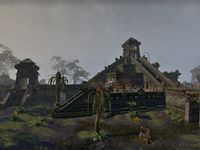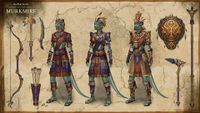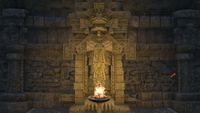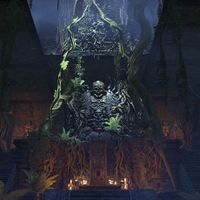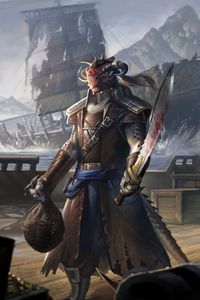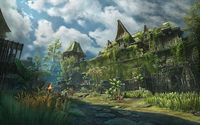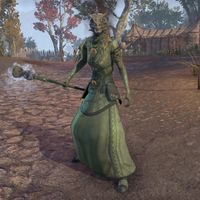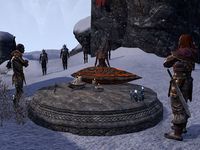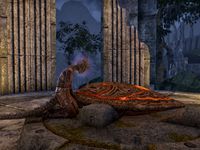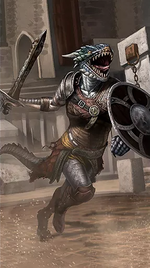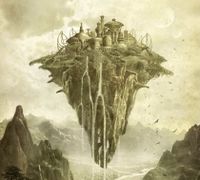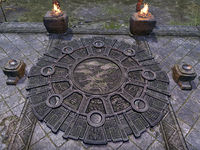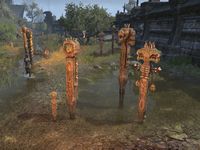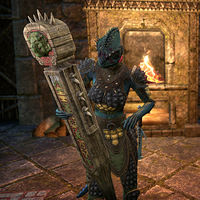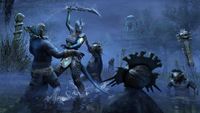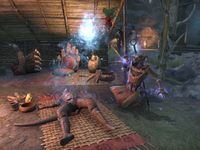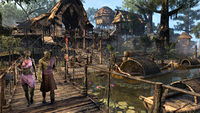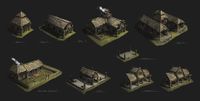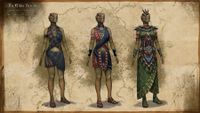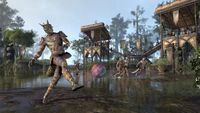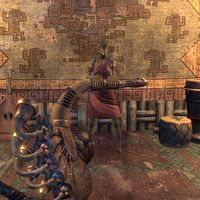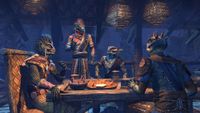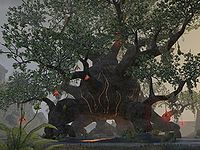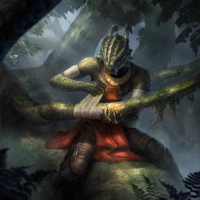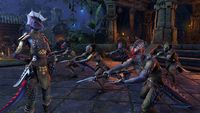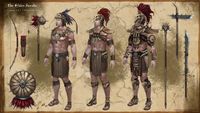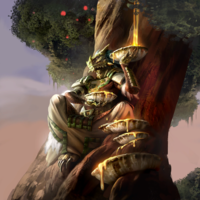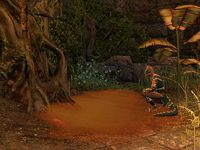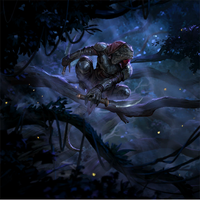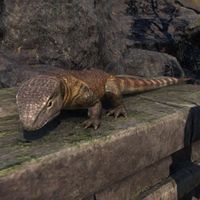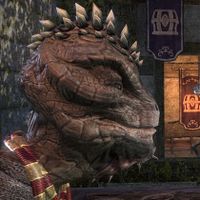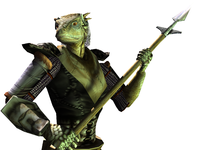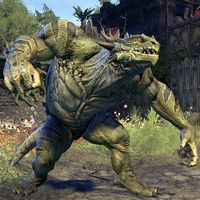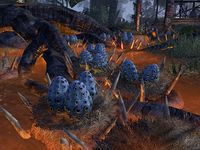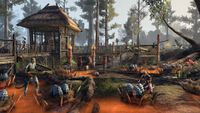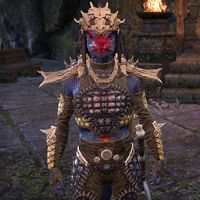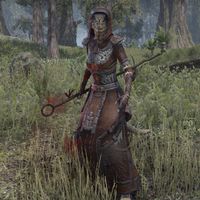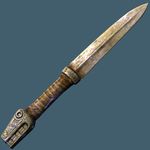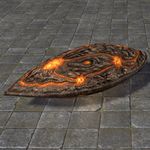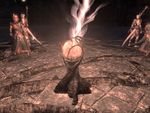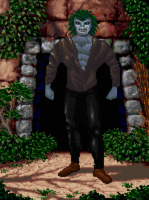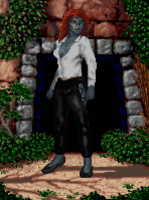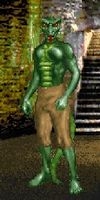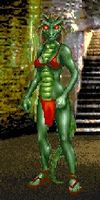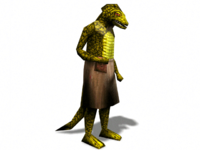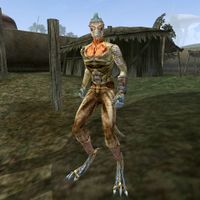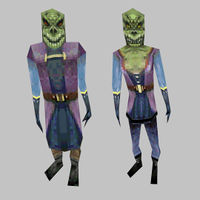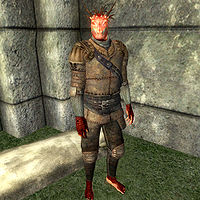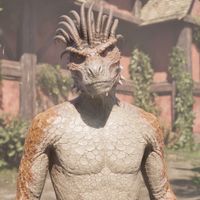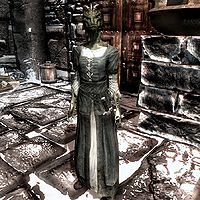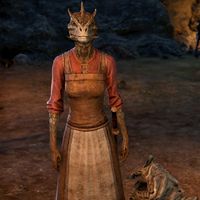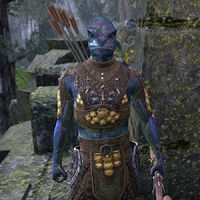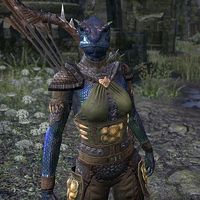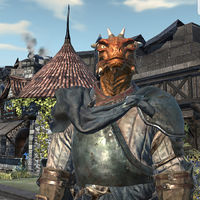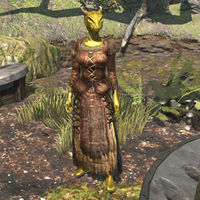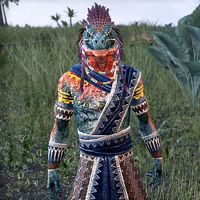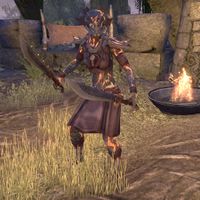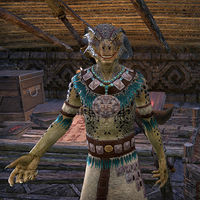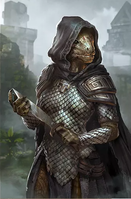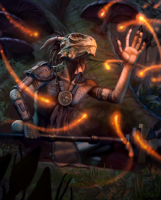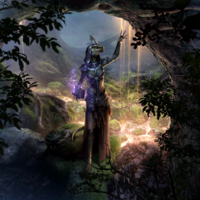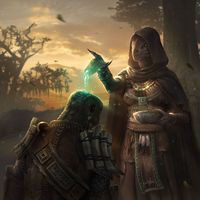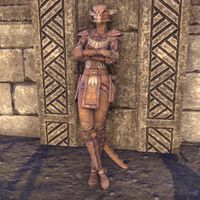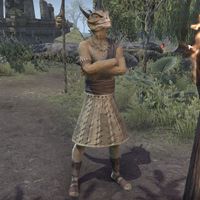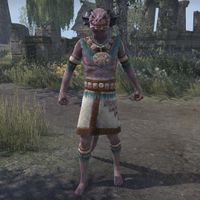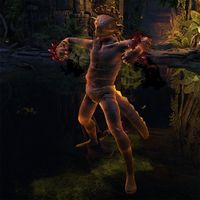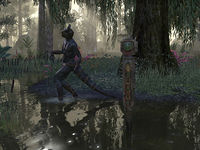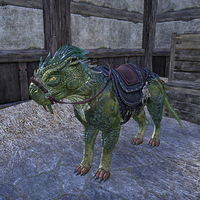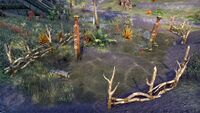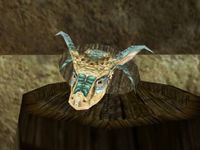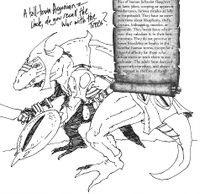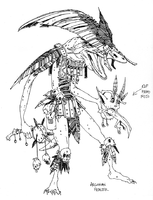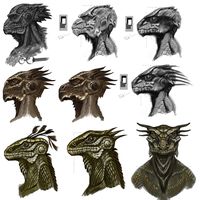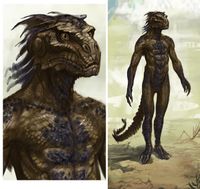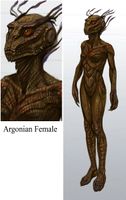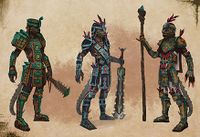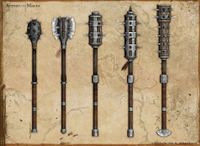Lore:Argonian
"Saxhleel" redirects here. This article is about the race. For the month, see Sun's Dusk.
Argonians (Saxhleel,[1] or People of the Root[2][3] in their native language of Jel) are the reptilian natives of Black Marsh, a vast swampland province in southeastern Tamriel. The other races often refer to them as lizards or the Lizard Folk instead, especially when meaning to be derogatory. They are known as the foremost experts in guerrilla warfare throughout Tamriel, a reputation brought upon them by defending their borders from enemies for countless centuries.[4][5] They have a connection to the Hist, a race of sentient trees.[6]
Agile and cunning,[7] they possess natural immunity to poison and disease, a trait that serves them well in their treacherous homeland.[8] Argonians are swift swimmers[9] and can breathe underwater.[10] They are also naturally adept spellcasters[2] and excel in the art of stealth.[11]
Foreign racial categorization labels them as "beasts", or "Betmeri", as opposed to the humanoid races of Mer and Men.[12] The Argonians' alien nature is often commented on; they are called strange,[13] expressionless, reserved peoples, slow to trust and hard to know.[14] This is a sentiment shared even by lukiul, or "assimilated" Argonians, who were raised far away from the Hist and often have significant trouble fully understanding the emotions, body language, or motivations of their estranged brethren.[15]
While most of Tamriel refers to them as the "Argonians", many Argonians prefer the term "Saxhleel" when referring to their kind;[16]:58[17] "Argonian" is an Imperial term.[18] Some Argonians opt to take on a more Cyrodiilicized name outside of Black Marsh.[1] Taking on Imperial dress, name, and customs makes things easier for Argonians in Cyrodiil.[19]
According to the First Era Scholar Brendan the Persistent, "The Argonian people have, throughout Tamrielic history, been perhaps the most misunderstood, vilified, and reviled of all the sentient races. Yet, those who have taken the time to experience Argonian culture have gained a greater appreciation for this noble and beautiful people."[20][17]
History[edit]
—Tsixotl
The Argonians were created by the Hist, a race of sapient spore trees. The Argonians were given life, form, and purpose by these creators. Their roots run deep beneath the soil and soft white limestone of Black Marsh, connecting them all, and thus connecting the Saxhleel. As the Hist are all connected at the roots, they have a collective consciousness, and can communicate with each other.[21]:34 Ancient cave paintings depict half-tree, half-Argonian figures—some of which appear to be more tree-like than Argonian.[21]:54
Stone-Nest Period[edit]
Long ago, Argonians lived in giant stone pyramids (called xanmeers)[17] that extended all across Black Marsh. This era is known to scholars as the "stone-nest period".[22] During this time, Argonian society was ruled by influential priest-kings.[23]
- → See the main article: Nisswo
The ancient Argonians (sometimes referred to as "the Old Ones" by the Saxhleel)[24] were capable of great feats, creating magical defenses that remained both functional and effective well into the Second Era.[25] It is theorized ancient Argonian society was more advanced and unified prior to Duskfall. However, a competing theory has been proposed that the ancient Argonians' trade connections simply reached farther than what was previously believed. The ancient Argonians were adept at metalworking and often used volcanic glass in their weaponry, the latter of which suggests they frequently ventured into what is now Morrowind. Some of their work was possibly even inspired by Dwemer designs.[26] The ancient Argonians used vakka stones to power some of their relics and devices.[19]
The ancient Argonians viewed Sithis as a destroyer. They feared change and Sithis' destructive force.[27] As a representation of this ideology, they built vast stone pyramids, known as xanmeers, to withstand the test of time. Fearing Sithis to this extent could explain why the old priests of Sithis were able to retain a position of power in Argonian society in the pre-Duskfall period.[27] Sithis had a more central role in this old society, and the ceremonies dedicated to Sithis were also different, including blood sacrifices.[26][28] Unsurprisingly, there was resistance to Duskfall among the priesthood, with some of them taking extreme measures to halt the approaching change. One priestess named Shuxaltsei managed to return briefly in 2E 582 and attempted to reclaim her temple in Murkmire.[29]
The ruins within Tsofeer Cavern, the Tomb of Many Spears, the Xinchei-Konu Monument and the Teeth of Sithis are examples of buildings from the pre-Duskfall era. The Xinchei-Konu was an ancient calendar that shows how the Argonians viewed time and tried to fight against change by manipulating the weather. The Teeth of Sithis is one of the largest known temples of Sithis.[30][27][31] Modern Argonians consider both the construction of the stone xanmeers and their predecessors' fearful devotion to Sithis as a result of a flawed belief system, as it only saw Sithis as a destroyer and not a creator as well.[27] Eventually, this society collapsed in a period known as Duskfall.
Duskfall[edit]
What Duskfall was, exactly, is largely unclear. Sources largely describe it poetically, such as "The Hist led the way" and "the Hist revealed the true path", implying the Hist trees were involved in some way with the event.[32][27] Interestingly, the Hist seemed to have some forewarning of the events to come prior to Duskfall, and not all were in agreement of how best to handle the approaching change. At least one Hist tree sought to keep their tribe safe from these changes by forming a pact with Molag Bal to wait out Duskfall within Coldharbour and preserve its people's traditions.[33] The Hist tree of Mazzatun disagreed with its bretheren, and instructed its children to build a sprawling city of stone forever instead of teaching them to adapt to the changes.[34]
The Hist trees that remained ceased all communication with the Argonian people for an indeterminate amount of time following Duskfall. It wasn't until the Argonian Jaraleet rediscovered a method of communication that communion between the Argonians and the Hist finally resumed.[35] Unfortunately, the secrets of Duskfall remained lost even after this, with the Hist trees either having lost the knowledge of Argonians from that era of their history, or simply refusing to share it.[36]
Argonian culture went through a paradigm shift as a result of Duskfall. Having previously viewed Sithis as a destructive force and living in fear of it, the Saxhleel now started to recognize Sithis not only as destruction, but also change. Simultaneously, they adapted a more cyclical view of time. The Argonians believed that the fear of death and impermanence, which they call "shunatei", is the reason both the ancient Argonians and the other civilizations insist on building giant stone cities.[3] Modern Argonians believe that by building impermanent structures, they conquer shunatei and become one with Change, or Sithis.[34][37]
- → See the main article: Duskfall
Exactly when and how this ancient society collapsed is unknown, but they were already living in established preliterate tribal communities around the time the Aldmer first began exploring Tamriel.[38][20][39] The ancient Argonians were swiftly displaced by the more technologically and magically advanced Elder Folk, and were driven back into the swamps of their homeland. Black Marsh in those times was inhabited by a multitude of races, from the diverse Kothringi tribes to the Cantemiric Velothi (and much later, the Barsaebic Ayleids) to the vulpine Lilmothiit, and they held the Lizard Folk in an almost myth-like sense. For some they were wandering curiosities, for others they were heroes that nobly saved non-reptilian inhabitants from horrors of the marsh, and for others still they were terrifying savages.[39]
First Era[edit]

Argonians only occasionally left their homeland during the early years of the First Era, though there are accounts of individuals being found in other parts of Tamriel during that time.[20] According to a Saxhleel ghost encountered in Stonefalls in 2E 582, the ancient Chimer utilized the Lizard Folk as slaves centuries before their descendants the Dunmer would do the same.[40]
The races' standard contempt for outside peoples originated in the latter years of the Alessian Empire, when pirates and other criminals often exploited Black Marsh's treacherous landscape to evade Imperial Law. The entirety of the eastern coastline of the Topal Bay was infamous for piracy, and in 1E 1033 Empress Hestra ordered for the head of "Red Bramman" (the most notorious of these criminals) to be brought to her in order to end the bandit activity.[20] The Imperial Navy was forced to enter Argonia through the Bay and traveled deeper into the swamps than anyone else had before, and finally beheaded the redheaded pirate-king in his bandit kingdom near the modern city of Blackrose.[17] The pillaging and slavery Bramman introduced into the Marsh made Argonians resentful towards the races of men, and their resistance to the continued use of the old pirate routes led to decreased exploration as the First Empire's influence waned.[20][17]
Despite this bitterness, the Argonians still allied with and aided the Empire when the deadly Thrassian Plague ravaged Tamriel in 1E 2200. Argonian freebooters joined alongside Redguard corsairs, Colovian galleys, Breton warships, and even Aldmeri cutters in the All Flags Navy—the greatest allied naval force in Tamriel history—to enact revenge against the Sload, a species hated by all the races of Tamriel. The Tamrielics succeeded in their mission, sinking Thras to the bottom of the Sea of Pearls (although it would later rise again), but a great number of their ships were unfortunately pulled into Coldharbour by a magical whirlpool.[41][42]
The Saxhleel were never conquered by the Alessian Empire. The Reman Dynasty, on the other hand, took great interest in incorporating Black Marsh as a province during their reign. In 1E 2811 the last army of the Lizard Folk was defeated by the armies of Cyrodiil, but Black Marsh itself continued to lay largely outside of Imperial control.[20] When Reman II ascended to the Ruby Throne, the unconquered territories of Morrowind and Black Marsh weighed heavily on his mind. He rashly decided to conquer Argonia in 1E 2830, and nearly lost as many men from the swamps as he did from the Argonians that resisted him.[43]
In 1E 2828, the Blackwater War was in full swing. One of General Sardecus's most trusted legates ordered a troop of sappers to set fire to a peat bog just outside Stormhold, unwary of the fact it was part of a larger underground network. This act was the catalyst for the Great Burn of 1E 2828. Months later, random fires were noticed as far as Soulrest and Gideon. The entire swamp was on fire, and it raged underfoot for over three years. The Legion was forced to stand down, as choking fumes and vents of burning swamp gas began erupting from the earth below. As the gas below the surface burned, it would eventually explode. Black Marsh was nigh-uninhabitable, even for the Argonians. Entire tribes were lost, and countless species of native flora and fauna were driven to extinction.[44]
The war suddenly and inexplicably seemed to end in 1E 2836, when the Argonians stopped fighting and went to living life in the swamps.[45] Reman II eventually managed to gain control of the northern and eastern sections of the territory, and declared those parts the Imperial Province of Black Marsh in 1E 2837.[43][6][46] Imperial scholars are unsure of why Argonian hostility ceased, but they speculated that it had something to do with their Hist worship.[45] Unsure of how to make use of the region's resources, the Imperials built several prisons in Black Marsh, thinking it was a good place for prisoners to be sent to and be forgotten.[47] Criminals not trusted in conventional dungeons and anyone deemed a political enemy by the Imperial government[48] could be relocated to one of several prisons, such as White Rose Prison and Blackrose Prison.[6][49]
Second Era[edit]
For thousands of years before 2E 582, the Dunmer had raided the land for slave labor, and in the process picked up and took with them anything else that was portable and might be valuable, including livestock.[50] Entire tribes were dragged off in chains to Stonefalls, Vvardenfell, and Deshaan.[49][20] The Dunmeri Great House Dres had been cemented as a Great House in times long past when its progenitor Thalthil Dres conducted a slave-raid on the city of Thorn, becoming the primary providers for the slave trade in their homeland.[51][52][53] While some Dark Elves saw the enslavement of the Argonians as a great uplifting and betterment for the race in general, the Lizard Folk themselves detested their so-called masters and resisted them constantly.[49][20]
The Argonians are rumored to be the creators of the deadly Knahaten Flu in 2E 560, which originated in the city of Stormhold and then spread throughout Tamriel like wildfire.[54] This claim has never been proven, but since the Argonians proved to be immune to the contagion, the other races quickly came to believe that an Argonian shaman manipulated their Hist tree into creating the plague in retaliation for the constant oppression of their people by the other races (specifically the Dunmer).[20][55] The Flu soured Tamrielic opinion of Argonians, who were thought to be carriers of the disease.[49] Many Khajiit blamed the Argonians for the Knahaten Flu.[56]
The Second Era also saw the rise of Keshu the Black Fin, an individual from the village of Seekhat-Yol in the greater marsh.[57] When she matured, she went on to befriend Prince Jorunn of Skyrim in Stormhold before returning home.[24] Witnessing Dark Elven slavery had a profound effect on her, so she gathered many volunteers from the greater marsh to form an army, which came to be known as the Black Fin Legion.[58] With them, Keshu waged war against the slavers of House Dres. As her victories mounted, her reputation grew, as did her militia.[59]
The Akaviri Invasion and the Formation of the Ebonheart Pact[edit]
Perhaps the greatest—and most surprising—historical event the Argonians took part in during the Second Era was the Liberation War, better remembered as the Second Akaviri Invasion. In 2E 572, a strong Akaviri force led by Ada'Soom Dir-Kamal attacked Windhelm in Eastern Skyrim, killing Queen Mabjaarn Flame-Hair and Princess Nurnhilde. Leaving the ruined city behind, the eastern army continued on their way to Riften but found it heavily fortified by the Nords, who were led by Jorunn the Skald-King and Wulfharth the Ash-King, the latter of whom was called back to Nirn from Sovngarde by the Greybeards.[60][61]
The invaders decided to bypass the Nordic city and entered Morrowind instead, where the Dunmeri army led by Almalexia fought hard, but were forced to retreat into Stonefalls (although it is rumored that Mother Morrowind and the Skald-Prince collaborated with one another to set this up despite their races' ancient enmity).[62] With their backs towards the Inner Sea, the Akaviri fought viciously against the combined Nord-Dunmer force, but with the rest of the Akaviri fleet on the horizon it seemed that the Tamrielics would be overrun and slaughtered.[62][63]
Sometime prior to the initial invasion, an Argonian slave named Heita-Meen escaped from the Dres plantation she was being forced to work upon alongside several of her compatriots, but was captured by the Dunmer-aligned Archein tribe and taken back to their village. During her captivity, she received a vision from the Archein Hist tree, which showed the Nords and Dunmer dying at the hands of the Akaviri. In this, she saw an opportunity. When she was taken back to Thorn, she killed her slavemaster and took control of the Archein guards by way of duel. She headed to Stormhold, where she was able to gain the support of a majority of the Shellbacks there, then made haste to aid the Dunmer and Nords in Stonefalls.[64] Jorunn sent a call for help to Keshu after Windhelm fell, and the Black Fin Legion assisted in driving the Akaviri from Morrowind.[59]
At first, the Dark Elves were alarmed to see a force of armed Argonians heading towards them; some even attacked the Argonians out of fear.[62] However, the three races were able to get over their mutual animosity, and resoundingly drove the invaders into the Sea to drown. At that moment, the Ebonheart Pact was formed and would continue to exist all the way through the Planemeld ten years later in 2E 582. Unlike the other three factions in the Three Banners War, the Ebonheart Pact focused largely on wiping away the rashness of Imperial rule as well as ending mortal scheming with higher powers from beyond Nirn.[65]
As a show of thanks for the Argonians' timely intervention, the Dunmer formally ended the enslavement of Lizard Folk. The practice of slavery itself did not end, despite the Argonians' liberation.[66] Some Dunmer refused to accept these terms and therefore withdrew from the Pact, notably House Telvanni. Likewise, many Argonians felt that the Dunmer deserved retribution for their crimes,[67] and only the regions of Shadowfen, Thornmarsh, and Murkmire in Black Marsh joined the Ebonheart Pact.[64] Some Argonians left their homeland entirely and settled in other provinces.[68][69] Eventually, the Great Moot that ruled over Morrowind, Black Marsh, and Skyrim consolidated their provinces into a single nation.[70]
During the Three Banners War, an anomaly known as the Mnemic Egg came to the attention of the Pact's leaders. The Mnemic Egg is a powerful artifact that is the physical manifestation of the Argonian-Hist link, and if severed can prove fatal to both. The Egg fell into the interests of the First Aldmeri Dominion, who attempted to use the Mnemic Egg to sever the link between the Argonians and the Hist, but were thwarted by Vicecanon Heita-Meen and the Vestige.[71][72][73]
It is unknown what became of the Ebonheart Pact, but by the time of the Tiber War it no longer existed, and the Argonians were once again the sole authority in Black Marsh. Saxhleel slavery was also revitalized in full by the Dunmer at some point, and despite the fear of the Knahaten Flu, House Dres continued sending slavers into the north of Black Marsh.[20] It is said that even Tiber Septim himself thought twice before attacking Black Marsh in his conquests, and it is implied in A Short History of Morrowind that the Argonian homeland was acquired by way of treaty instead.[74] Despite this, the borders of their province fell quite easily to his forces and he avoided much loss by neglecting to attack the almost impenetrable inner swamps.[20] The Argonian homeland was assimilated into Tiber's growing Empire sometime after the First Treaty of Stros M'Kai.[75]
Third Era[edit]
During the Third Empire, the homeland of the Argonians continued to function mostly as a prison state, and the Emperors were content with holding on to the strategic regions on the coastline instead of annexing the heart of Black Marsh, which remained outside of Imperial governance.[20]
In 3E 396, during the Imperial Simulacrum, a slave revolt escalated into the Arnesian War with Black Marsh being defeated by Morrowind, which took a significant amount of territory (and undoubtedly many new slaves) when the Argonians lost.[20][76] Although the enslavement of any civilized race was illegal in the rest of the Empire, the Dark Elves were allowed to continue the practice due to the favorable conditions of the Armistice under which Morrowind joined the Septim Dynasty, which allowed the Dunmer to follow their ancient traditions and maintain great autonomy in their domestic affairs. King Helseth eventually abolished slavery in Morrowind for a wide variety of reasons.[77][78] With the abolition of slavery, the Argonians' relationship with the Dunmer vastly improved, although violent attempts to reclaim the lands stolen from them during the Arnesian War continued.[20]
While Imperial governors ruled over the coastal cities in the province, many of them had Argonian advisors from the Archein tribe (whom other Argonians regarded as "pompous, assimilated slaver kleptocrats").[79] The Archeins, in turn, ruled over the rural areas that made up most of Black Marsh. Beyond the reach of the Emperor, there was little to no governance in the innermost swamps, and it was unknown if the inhabitants of those areas even recognized Imperial rule.[20]
When Mehrunes Dagon attempted to invade Tamriel during the Oblivion Crisis in 3E 433, the Hist trees foresaw his coming and called many Argonians back to defend their homeland.[78] The Argonians were altered by the Hist in order to combat the Daedra, becoming faster, stronger, and able to endure harsher punishment.[16]:59 When the Oblivion Gates were opened in Black Marsh, the Lizard Folk charged into them so viciously that the Daedra themselves were forced to close them in order to avoid being overrun. Because of this, the Argonians emerged from the Oblivion Crisis more united and stronger than ever before compared to the other Tamrielic races, who were devastated by Dagon's plot.[21]:19
Fourth Era[edit]
The Argonians were among the first of the races to secede from the weakening Empire, alongside the Khajiit of Elsweyr.[21] Shortly after the eruption of Red Mountain devastated Vvardenfell, the Argonians attacked Morrowind in an event known as the Accession War. Sources vary on why it was started. Some claim that it was incited by the Thalmor.[80] Others say that it was the years of slavery that caused them to attack, or that it was an attempt at expansion.[81]
Whatever the case may be, they had early success in invading southern Morrowind, sacking many cities (including Mournhold) and advancing as far as the ruins of Vivec City.[21] However, the Argonians were eventually repelled by the army of House Redoran, who stopped the Argonians from invading the rest of Morrowind.[21][81] Though Mournhold was reclaimed by Morrowind and is presently undergoing restoration efforts, the status of all lands invaded by the Argonians remains ambiguous.[82] The Argonians are known to have patrols as far north as Skyrim's border,[83] and control areas as far inland as the mainland portion of the Scathing Bay,[21]:259 bringing House Redoran's claim of total victory into question.[84] Some Argonian tribes hold territory in regions that border Black Marsh.[85]
—Mere-Glim[21]:59
Sometime in the early Fourth Era the Argonians came to be governed by a political party known as the An-Xileel, whose views were completely nationalistic. In 4E 48, the An-Xileel were able to use the rogue Hist of Lilmoth to summon the floating city of Umbriel from Clavicus Vile's realm in Oblivion in order to exterminate all foreign taint in Black Marsh.[21]:36 The An-Xileel and the Wild Ones went away, intending to come back when the ordeal was all over and the Imperial taint had been scrubbed from the province.[21]:62 When Umbriel finally arrived in Black Marsh, the rogue city tree reached out to all Argonians within range of the floating city, compelling them to walk beneath it and relent to the undead horde it controlled, giving their souls to fuel the ingenium.[21]:59
The city did this for them, but soon began following its own agenda after the An-Xileel lost control over it. Umbriel started on a northwestern path towards White-Gold Tower in the Imperial City, moving through Black Marsh and Morrowind in the process; those slain by the floating city were resurrected as an invincible undead horde to aid the city's dark goal. The Argonian cities of Stormhold and Gideon were overrun by the undead army of Umbriel despite not being beneath Umbriel's shadow. It was through the efforts of the Breton girl Annaïg Hoïnart, an Argonian named Mere-Glim, Prince Attrebus Mede and the Dunmer mage Sul (along with a few others) that Umbriel was finally destroyed and its threat to Tamriel eliminated.[16]
Saxhleel history has remained largely quiet for the rest of the current era. In 4E 150, a small force of Argonian raiders landed on Solstheim to stir up trouble, but were repelled by the Redoran of Raven Rock.[84] Smugglers in Skyrim's southernmost hold, the Rift, regularly complain about Argonian patrols along the border to Morrowind, implying the Lizard Folk have retained some land up north.[83][86] In spite of these patrols, the Dunmer have since managed to reclaim the area surrounding Mournhold.[82] It's also known that there are Argonians living at farms inside Morrowind. [87][88]
Culture[edit]
Marsh-born Argonians enjoy wallowing in cool mud[89] and water[90][91][92][93] and basking in the sun.[94][95] Some Argonians appear as though they're sleeping when they bask.[96] Contrary to what some foreign scholars believe, Argonians do not worship the sun. Rather, they enjoy its warmth[97] and bask in its light.[98] Wallowing helps to cool their scales and keep them from drying out on hot, sunny days.[99][100] When they wallow, one might find an Argonian with their nose barely poking out of the mud.[101] Black Marsh has just the right climate to suit their scales: the dampness of the marsh keeps it from being too dry, there are plenty of trees to provide shade, and it's not too open.[102]
Argonians hatched in places outside Black Marsh cannot hear the Hist.[103][19] These individuals are referred to as lukiul, or assimilated people. The term is used to describe Argonians that have assimilated into a non-Argonian culture.[98] Argonians who leave the swamp to live among non-Argonians are also considered lukiul.[104] An Argonian born as a slave on Vvardenfell would be considered lukiul, and would have no connection to the Hist.[103][19] Lukiul have difficulty understanding the body language of marsh-born Argonians,[15] and they are often treated as outsiders by the natives of Black Marsh.[98]
Traditional Black Marsh inhabitants refer to themselves as the Saxhleel, and they are suspicious of visitors.[17][105] Despite the distrust shown by the locals, lukiul are more or less left well alone. Those who've never left the swamp pity the lukiul, as they cannot imagine a life away from the Hist. Those who leave Black Marsh and return may feel greater longing for the Hist than when they left.[104]
Cultural Mindset[edit]
Argonians possess the most alien personalities in all of Tamriel from a human or meric perspective. They tend to speak with a certain detachment that might seem particularly strange to individuals with a formal upbringing centered around manners. Argonians do not facially express their emotions as much as men and mer do, though anger is fairly easy to detect through bared teeth and narrowed eyes.[17] Argonians are fiercely loyal and will fight to the death for those they have named as friends. Their allies have long since learned that there is always a reason for everything they do.[66]
Something remarkable about the Argonian people is that their culture seems to easily forgive the slights committed between tribes. This is due in part to their belief in reincarnation. A Bright-Throat may be reincarnated as a Black-Tongue after death, a Miredancer may return as one of the Root-House People, so on and so forth. For the Argonians, to hate each other is to hate themselves because they are all people of the root: it is better to forget and move on.[106] Because of this, the Saxhleel, like the Bosmer, prefer to live in the Aurbical Now–not dwelling on the past or the future, but simply the present.[107] The concepts of "past" and "future" are foreign to them.[108] They pay little heed to the passing of days.[34]
Moreover, they care little about the relics within the ancient xanmeers dotting the marsh unless they have to. Some xanmeers contain powerful relics or cursed antiquities, and the Argonians would prefer not to have objects such as those floating around. They also have no use for the more benign trinkets found within the ruins. They do not want or need the relics within their people's ancient ruins; they would rather have more practical things, such as fresh slugs to feed themselves, and sturdy tools to hunt hackwings or repair their reed houses.[3] Some Argonians, like Keshu the Black Fin, aspire to great things. Keshu in particular wanted to resurrect the advanced Saxhleel society of old, an uncommon, but not unheard of, aspiration. The elders, sap-speakers, and tree-minders struggled with the notion at first, but they did not stop her. To the Argonians, if someone succeeds in their goals, then those plans were meant to come to fruition. Those who fail disappear into the marsh, never to be heard from again. That is the way things are in Black Marsh.[58]
While the concept of time is foreign to them, the passage of time is not meaningless. The months on the Argonian calendar do have significance to the people of Black Marsh. The Saxhleel recognize that the passage of days is inevitable and part of a perpetual cycle. Marking the progression of that cycle is sacred.[109] A book titled The Seasons of Argonia explains the months and their significance in detail. Argonians who pay heed to the passage of time are called jekka-wats.[34] A jekka-wass is assigned to be the keeper of an ancient Argonian monument known as the Xinchei-Konu, a giant stone calendar located in Murkmire. The Xinchei-Konu is not just a calendar, it is a catalyst of change; it can be used to change the weather.[30]
Change, or "vastei", is perhaps the greatest driving force behind the Saxhleel's motivation. To the Saxhleel, defying change is the greatest folly.[98]
Calendar[edit]
The Argonians have different names for the months of the year than the rest of Tamriel. The following is a synopsis of the months and their meaning, in chronological order:
- Vakka: The first month represents origins. Tribes are encouraged to show respect to their elders during this time.
- Xeech: A month of planting, hopeful, but also melancholy. The First Mourning (out of three) occurs during Xeech: once a thing it is planted, it is hidden and gone. What emerges will not be something new: the nut is lost forever.
- Sisei: Celebrates youth and possibility. Sports, competitions, and hatchling festivals take place during Sisei. Strength, speed, and willpower are also celebrated. This season is a time for romance and renewal. Bright colors are typically worn this time of year.[110]
- Hist-Deek: A month dedicated to challenging authority. Injustices are brought to light, conflict between tribes occurs, and individuals reflect on their agency as well as their bond with the Hist.
- Hist-Dooka: Family, tradition, and obligation are celebrated. Youngsters are given more responsibility, and many adolescents undergo their Chukka-Sei. The month typically ends in celebration.
- Hist-Tsoko: The holiest month of the year, dedicated to the ideas of knowledge, wisdom, and fullness of potential. Gatherings are often solemn. Hist-Tsoko represents the Second Mourning: the Hist has stopped growing, and its full potential has been reached.
- Thtithil-Gah: Wonder and simple joy are celebrated. Traveling entertainers make most of their money during this month, and festivals and feasts are constant.
- Thtithil: Associated with anticipation, mystery, and finality. Thtithil is a time when many tribes begin laying eggs.
- Nushmeeko: This month celebrates hard, thankless, everyday work. The entire tribe labors near-constantly during this month, doing whatever needs to be done around the village.
- Shaja-Nushmeeko: Another month of mystery and debate. Unifying concepts such as change, becoming, and shifting values are all contemplated. Adolescent gatherings often happen during this time, and many young ones dip their tails in romance.
- Saxhleel: Tribe members are free to pursue their creative passions, such as pottery and woodcarving. In many tribes, a large gathering of elders is held to prepare them and the community for the impending deaths to come. Saxhleel encompasses a sense of things coming to a close, as it's the second to last month of the year.
- Xulomaht: Xulomaht is associated with the Third Mourning, which is the most significant of the three given the end of the year. Communities reflect on the past year and mourn its passing. They also look forward to the next year. Festivals are held to remember those who have died.
Death[edit]
When an Argonian dies, their corpse is laid to rest in the marsh to return to the Hist, so their soul may be incarnated once more. Burying the bodies, or at least allowing them to be among nature, allows them to return to the Hist. Argonians that have died away from the Hist, even in stone prisons such as White Rose, can return to the Hist by bringing their bones to the dirt.
Traditionally, the deceased is fitted with a wooden funerary mask and buried in the ground. A xul-vaat, or grave-stake, is used to pin the corpse into the mud (whether it's buried or not) so it doesn't float up to the surface when the marsh inevitably floods. This also prevents corpses from rising as an undead bog blight.
The xul-vaat don't just prevent the corpses from floating to the surface of the bog: the deceased's story is carved upon their stake. Tales of their victories and defeats, tales from childhood, names of friends, dreams, and nightmares—a grave-stake tells those who see it about the corpse it impales. Each stake planted into the mud tells a story, some as old as the marsh itself. Sometimes they are laid at the roots of the Hist. Others are buried in graveyards or a place that held sentimental value for the deceased, and for some the body is staked where it fell. The stake marks the burial site and serves as a remembrance until it is claimed by the swamp.
When death arrives to a tribe, the tribe's grave-singer is called upon to tend the corpse and stake it. The grave-singer is tasked with reading their tribe's stakes, and when someone dies, they sing the fallen one's final song. Grave-Singers care for the bodies of the fallen and deal with death, however it may appear to the tribe. The grave-singer of the Naga-Kur has an additional task: harvesting scales, skin, bones and other parts from the bodies of the fallen as needed, so the tribe can make weapons and armor. Argonian spirits return to the Hist when they die; the Naga-Kur do not bind their spirits to the weapons they make with the bones of their fallen kin.
Sometimes, grave-stakes come loose, usually by being pulled from the mud by an unsuspecting or malicious individual. When this happens, a formerly staked corpse can rise from the dead as a bog blight. They have been described as "dead-and-not-dead things that eat Nagas whole", and are dangerous in large numbers. Bog blights can be kept at bay with the use of pahnjees (or "fumers"), racks of oily, spoiled meat that mask a living person's scent from bog blights. Life energy clings to grave-stakes. This powerful force can be used to fuel necromantic rituals.
Argonian Souls[edit]
Argonian souls are different from those of other races due to their connection to the Hist.[111] Argonian souls return to the Hist after death because of this connection. A Hist tree's sap is its soul. When an Argonian is created, the Hist's sap becomes the Argonian's blood, essence, and soul. Argonian spirits are made from the essence of their Hist tree, which is the sap. If a Hist tree were drained of its sap, the souls of the tree's tribe will have nowhere to go after death. They may linger in the world of the living, trapped in madness. If the sap were to be boiled or distilled by whoever took it, the Hist would be in great anguish, an unbearable sensation that the souls of its tribe would feel. If the tribe's tree-minder possesses a relic gifted to the tribe by the Hist, such as a staff made from one of its branches, the relic can be used to call the tribe's spirits and the tree's sap back to the Hist. In that case, the souls would pass on, and the tree would survive.[112]
Those who commit blasphemies against the Saxhleel are punished by denying them the ability to return to the Hist. This can be done by binding them to an urn. None of the Argonians buried following the rites of the Hist are anointed with Arkay's Blessing, which in the very least prevents the souls of other races from being used without their consent. Even so, it is uncommon for foreign necromancers to come to Black Marsh to practice their art, because corpses decay very quickly.
Art and Architecture[edit]
Long ago, the Lizard Folk built and lived in grandiose pyramid structures they referred to as xanmeers and had wayshrines dedicated to the stars.[113][114] However, these were consequently abandoned following Duskfall, and the Saxhleel themselves do not recall much about life in those times.[114] During the Second Era the Argonians of Shadowfen lived in huts made from mud,[17] while those in Murkmire constructed settlements woven from reeds.[115][116] Because of this alarming change, some scholars doubt that the xanmeers were built by the Argonians, who in their opinion merely claimed ownership of them. Feathers, bright colors, and lizard hides decorate the majority of their buildings and works of art.[17]
Reptilian symbolism is prevalent in Argonian art. Turtles, lizards, crocodiles, and other scaly creatures are often the subject of artistic expression.[117] Turtle shells are often used to craft dishes, such as platters[118] or mugs. Particularly fancy products might be inlaid with mother-of-pearl.[119] Argonians use hide from giant snakes to protect delicate textiles.[120]
Modern Argonian architecture is shaped by the concept of conquering shunatei: "the pain caused by holding on too tightly to that which has come to pass", also described as the "Fear of Death and Forgetting". Argonians feel that building stone structures in the belief that they will endure the centuries is foolish, and point to the countless other ruins that dot other provinces as proof of the inevitability of their destruction. Because of this, they instead build structures that are intended to be temporary.[121]
Argonians are said to be masters of jewelry making, which is sought after in many provinces.[122] The Argonians also seemed to be the pioneers in the arts of alchemy, as their alchemists in Black Marsh have long held that the moon phases dictate the precise positioning of calcinators.[123]
Ceramic art is commonplace in Black Marsh. The Argonians make pots, bowls, spice shakers, and other dishes and utensils out of clay.[124] Glass and bone are also used in Argonian crafts.[125] Though wood is destined to rot in the humid swamps, Argonians don't shy away from using wood in their crafts.[126][127][128] The art of weaving grass and other fibers is commonplace in Black Marsh. Argonians are known for their sturdy weaving techniques, secrets which they guard closely.[129] Specialized bronze tools called "bone-workers" are used to carve bone, horn, and chitin for Argonian art. The tool performs the functions of a knife, pick, and chisel.[130]
In Murkmire, some of the locals use razor-sharp pieces of volcanic glass to skin their beasts.[131] The inhabitants of Xal-Ithix use barbed, four-tined spears with double-hinged folding hafts made of bamboo to hunt frogs.[132]
Fashion[edit]
Argonians occasionally dress up their tails, whether they have a practical reason to do so or not. A colorful band of leather makes for a simple accent on the tail, and some Argonians spruce it up by attaching bells or other decorative elements to such garments.[133] Specialized stockings with pockets to place hot stones in can be worn on the tail to keep it warm.[134]
Argonians often decorate themselves with spines and plumes.[135][136] Horn adornments are also common: copper horn caps were popular during the "capping" trend of the Second Era.[137] In the Second Era, lukiul started a trend of using fashionable silver clips to hold their frills in place.[138]
Naheesh elders are often adorned with feathers from the betva-hen.[139]
Entertainment[edit]
Their tendency to go with the flow and shrug off the loss of worldly things doesn't make the Argonians averse to fun. They have invented several sports, some of which involve the use of a ball, or "teeba".
- Teeba-Hatsei: Teeba-Hatsei (meaning "Hip and Tail Ball") is a uniquely Argonian sport that makes use of their tails. Hands and feet are not used to hit the ball; only hips, elbows, and tails.
- Teeba-Enoo: Teeba-Enoo is an Argonian pastime that is both a ritual and a sport. There are many rules, and they are always changing. The rules are very confusing to outsiders. Plenty of Saxhleel also have trouble understanding the rules.
There are also several Argonian board games. Shells and Stones[140] is played on a small, flat reed mat with strange markings on it.[141]
Music[edit]
The Argonians have invented an instrument called the vossa-satl (also called "frog pipes"). The instrument resembles a polished wooden clam shell with a series of valves along the top. Each "segment" of the shell is a small, hollow compartment with a mouth like a bugle; each chamber is a different size and produces a different tone. The musician places a live frog into each compartment. There are many kinds of vossa-satls: some are as small as a jaw harp, and some are as large as a pipe organ.[142] To tune their instrument, the vossa-satl player twists a tuning key to alter the size of the frog containment chambers.[143] Tuning a vossa-satl requires a good deal of patience, especially when the frogs are in mating season.[144] Musicians wear pouches full of wriggling frog treats on a cord around their neck.[145] There are nests in each of the frog compartments, and the frogs are kept happy and well-fed so they sing at their best.[146] The happier the frogs are, the better the music is.[147]
Before each performance, the musician squirts a few drops of frog musk into each compartment to goad the frogs into singing. By pushing the valves on the instrument's neck, the musician muffles some chambers while leaving others open. The pipes produce a sound of their own, which is supplemented by the frogs' croaking.[142] The vossa-satl is one of the most difficult instruments for foreign musicians to master.[148] Instrument crafters go out and catch frogs that produce pleasing tones for their vossa-satls.[149][150]
The Fredas Night Stingaree is a tradition in Stormhold. Some participants wear fancy, lacquered wasp thoraxes on their tails,[151] while a musician plays "Dancing on Eggs", a traditional jig, on a uniquely styled slide flute. These flutes are usually made of silver.[152]
Language[edit]
- "Much of the nuance of Argonian conversation blooms from heavy metaphor and subtle body movements." – Lights-the-Way, Mystic of the Mages Guild[98]
Jel is the language of the Argonian people, and is unique among the other Tamrielic races by being unrelated to ancient Ehlnofex. It came from the Hist, the creators of the Argonian people. It also has no past tense or future tense verbs, only present tense. There is less emphasis on past and future, and more emphasis on the now, the recent past and the close future. Aside from the purely verbal communication, Argonians also utilize body movements to express their attitude to the subject they're speaking about.[153]
While many Argonians can speak other languages, even the most skilled linguists from other races struggle to gain even a basic grasp of Jel. With its use of hisses and other noises, it is described by some as impossible to be spoken correctly by other races, though it is still advised that visitors learn at least a few key phrases.[98] The throats of non-Argonians can't make all the proper sounds.[21]:33 Jel can be described as "the closest speech to real thought". Some Argonians feel that languages comprised merely of words only serve to limit the expression of thought[21]:33—true thought is close to the root.[21]:34 Some of the more isolated tribes of Black Marsh will commonly speak in this manner, with phrases such as "I bare my teeth" or "I roll my eyes" being commonplace during discussions.[153] People from other races often have difficulty reading Argonians' facial expressions.[101]
Jel is occasionally referred to as the swamp-tongue[3] or the root's tongue by native speakers. People who do not speak Jel are referred to as "ojel", literally meaning "Not of Argonian Tongue" or "Non-Speaker of Jel". It is often used to refer to outsiders, but isn't a derogatory term.[154]
"Wamasu scale treatment" is a euphemism used to refer to an impossible task.[155]
Medicine and Grooming[edit]
In Murkmire, pickled frogs eyes are used to settle a sour stomach. Some tribes consider them to be a delicacy.[156] Dried tree bark may be chewed to relieve headaches or minor aches and pains.[157]
Argonians also have many products used for moisturizing scales and frills. Soothing balms derived from palm oil can be used to keep spines healthy and moist.[158] Polish can keep the spines looking suave.[159] Clay lotion may be used to soften thick, rough scales,[160] and some folks lacquer their scales to improve their luster.[161] Creams derived from substances like kwama wax can be applied to the scales to keep them shiny and moist.[162] Herbal moisturizers intended for Argonian scales are known to irritate the skin of every other race.[163] Some oils intended for use on leather can be used to keep Argonians scales smooth and shiny.[164] Argonian ladies may carry a parasol to keep their scales from drying out in the hot sun.[165]
Small metal blades are designed for Argonians to use to clean their bodies. These specialized blades help scrap mites, dirt, and residual buildup off the scales.[166] Brushes with rigid bristles serve a similar purpose in getting dirt out from beneath the scales.[167] Clam shell claw files can help the discerning Argonian dull or sharpen their claws.[168] Thin, elongated whetstones are ideal for sharpening the horns.[169] Cylindrical sharpening stones with a hollow center are used to sharpen the teeth for defensive or cosmetic purposes.[170] Argonians of high status keep Corimont Mouth-Plovers (a kind of bird) to clean their fangs after meals.[171] A mixture of ground, ultra-hard bug shells can also be used to clean debris out from between one's fangs.[172]
Smooth, waxy fin polish is used to enhance the health and appearance of one's fins.[173] Some Argonians use ridge liner in an attempt to elongate the apparent size or depth of their facial and head ridges. This is comparable to the purpose of contouring or mascara in makeup used by men and mer: the gel is supposed to make their ridges seem more pronounced.[174] Argonians can make use of specialized polish for their horns. Expensive varieties can be made from valuable reagents, such as gold.[175] Cosmetic fragrances developed by the Saxhleel tend to follow trends that may seem odd at first glance, such as the bladder-aged "snake sweat" perfume.[176] Some Argonian colognes smell so strong that only the Saxhleel could find them alluring.[177]
Argonians moult; they shed their scales every now and then to make way for new ones.[178] Sometimes, they have difficulty losing their old scales, which may cling to their bodies.[179] Thick brushes are designed for rubbing off shedding scales, but are detrimental to the dermal health of other races.[180]
Food[edit]
- → See the main article: Argonian Cuisine
Argonian cuisine is perhaps the most impenetrable for outsiders. Composed largely of raw fish and swamp plants collected throughout the marshes, Argonian dishes are often difficult for outsiders to acclimate to. Argonian chefs make use of ingredients that cooks of other cultures would shy away from, such as maggots and fermented pond scum. Fish and small creatures that are harvested in nets and traps are often seasoned with spices and rich sauces, then eaten raw.
Drugs[edit]
Daril, literally meaning "seeing everything in ecstasy" in Jel, is a dangerous substance[181] derived from moon adder venom. The aforementioned venom is instantaneously fatal to all but Argonians, and is transformed by an agent in Argonian blood. Those who use daril can see sounds, hear tastes, and smell sights. Daril unfolds in stages, each unlike the last, and confuses the senses.[21]:131 It cannot be safely taken by non-Argonians.[181][182][183] Daril is very difficult to acquire; the venom is usually fermented in a swamp jelly gas bladder.[184] Some Argonian users coat tiny quills in daril and insert them into the skin around their eyes for an intense sensory experience.[185] The use of daril dates back thousands of years. In ancient times, stone mortars were used in the process of fabricating the drug.[186]
Some Argonians, especially Bright-Throat elders, enjoy smoking dried marshweed.[187]
The Argonians' natural resistance to poison also makes them resistant to the effects of drugs like Alcohol, requiring higher doses than other races for the effects to kick in.[188]
Miscellaneous[edit]
The following is a list of miscellaneous aspects of Argonian culture:
- Some Argonians fill their pillows with live centipedes because they enjoy the pleasant wriggling sensation.[189]
- A sentimental Argonian may press and preserve a leaf from their Hist tree to remind them of their tribe and family.[190]
- Heavy, inlaid wooden boards set in a series of octagonal patterns may be used in meditative exercises.[191]
- Argonian effigies reported to ward off nightmares are sold to people in other provinces by foreign traders.[192]
- Enterprising scam artists sell imitation Hist seeds to gullible foreigners seeking their reputed fertile properties.[193]
Society[edit]
Most, if not all Argonian tribes revere and build their lives around a Hist tree. They ingest its sap during rituals, lay their eggs among its roots, and often live according to the Hist's will. Tribes that build their lives around a Hist often do so literally, as they construct their settlements around the Hist.[194][195][196] The Hist guides them, and its people serve it in kind.[3]
The Argonian way of solving disputes differs from that of the Imperial province. Murkmire, for instance, doesn't have laws; at least not in a sense understood by outsiders. Small disputes are handled by an arbitrator of both parties' choosing. This can be anyone, though it tends to be the tribe's tree-minder.[197]
Tribal Leaders[edit]
Argonian leaders known as tree-minders tend to the tribe's Hist and seek its wisdom through communication with the tree. On rare occasions, the Hist may speak directly with an individual, though most tree-minders can interpret signs sent by the Hist.[198] Tree-minders can feel when something is wrong with their Tree. Occasionally, that something may be physically harming the Hist, such as sapthief beetles, but other times, it can be something deeper.[199] If something is wrong with the eggs in the uxith or the Tree senses an issue with members of the tribe, the tree-minder will feel it.[198] The tree-minder interprets the Hist's will so the tribe may carry it out.[200]
Some tribes possess a sap-speaker, who is a direct intermediary with the Hist. The sap-speaker will spend days or weeks at a time among the roots and canopy of the Hist; ingesting sap, eating the otherwise forbidden fruit of the tree, and using many hours of the day to indulge in solitary contemplation. The sap-speaker emerges from their solitude with the knowledge they've acquired from the Hist during their long bouts of study.[140] Sap-speakers have been described by Argonians as "Saxhleel blessed by the Hist with second-eyes and second-ears".[201]
Many tribes have an individual known as a root-herald, who works to protect their tribe's interests. While some tribesmen hunt for wamasu, the root-herald hunts for information and fruitful relationships.[3] They foster relationships that benefit their tribe, such as negotiating trade agreements.[202] They also gather information from townsfolk and associates, such as stories and rumors from outside the tribe. Some outsiders may liken their behavior to that of a spy, but such a concept is foreign to the Saxhleel. A root-herald cannot serve their tribe without gathering stories and rumors. Their purpose lies not in subterfuge or espionage. Rather, the root-herald's purpose is closer to that of an ambassador, or someone who brings in news to the tribe from the outside world.[3]
Life in the perilous swamp warrants the existence of kaal—war-captains.[203][204] The more war-like the tribe, the more this title is revered.[98] Some tribes also have a raj-kaal, or war-chief.[204][205] The name is self-explanatory: the raj-kaal is a war leader. Tribes that value their warriors may have a ka-deelith, or war-teacher, who trains novices to become full-fledged fighters.[205] Argonian tribes also place great emphasis on their naheesh: their tribal elders. They are the wisest members of the tribe, who carry the Root Talk and know all the sacred croaks and Chukka-Sei naming secrets.[115] The Root Talk is a solemn affair that usually occurs during the month of Hist-Tsoko, a time dedicated to wisdom and knowledge. During Root Talk, the tribal elders recite the history of the Saxhleel.[109] Though the naheesh are greatly respected, their title does not indicate that they are in a position of power. Another honorable title is that of the deelith: one who passes wisdom to another.[98] There is also the raj-nassa—an elder leader, and raj-deelith—an elder teacher. A tribe's elder leaders may determine what young Argonians must do to complete their rites of maturity, and the raj-deelith prepares the hatchlings for the rite.[206][207]
Warfare[edit]
Argonian arms and armor differ between tribes, and designs have changed with the passage of time. Ancient Argonians from pre-Duskfall times used volcanic glass, elaborately layered cloth, leather, bone and bronze to arm and protect themselves. Their weapons and armor were often adorned with feathers, dyed yarns, jewels, bronze emblems, and gold. The use of metal is almost unheard of in many post-Duskfall aspects of Argonian craftsmanship.[26]
The Naga-Kur of Murkmire craft weapons and armor from the bodies of their deceased. Scales, hide and bones from their dead are fashioned to protect the living. Frills and spines from the deceased may serve as decoration, while bones often make up the handles and business-ends of Dead-Water weapons.[208]
The Xit-Xaht of Mazzatun crafted lightweight armor that relied on sturdy leather and bone to protect the flesh of the wearer. Armor and weapons were designed to allow the Xit-Xaht to move swiftly in the marsh and hit their targets hard. Layers of bone are constructed to deflect blows, though Mazzatun craftwork often leaves the midriff exposed. Plumes, avian and reptilian skulls, and the spiraling path sigil of the city of Mazzatun often adorn the Xit-Xaht's arms and armor, making them easily identifiable from other tribes.[209] Argonian armor from the Shadowfen region, dated to the Second Era, often utilized bones, tortoise shell, shells and snakeskin to protect the wearer. Feathers, jagged teeth, turquoise, and jade often made up the adornments on crafted pieces, with spiral and geometric designs featuring prominently in ornamentation.[101]
The heavy infantry of the Argonians are known as Shellbacks.[17] Kaals may rally their own units of elite shellback warriors.[210] Argonian shields are sometimes made from turtle shells. If not the entire shield, a turtle shell may instead serve as a decorative boss for one.[211] Argonian blacksmiths make use of vises composed of hard shells and metal.[212]
Religion[edit]
Except for the more deeply assimilated, the Argonians do not formally recognize or worship any type of Tamrielic deity.[213] They revere their creators, the Hist.[112] Marsh-born Argonians can hear the Hist—when they place their hands on its bark or rest beneath its boughs, they hear whispers or songs, and can perceive faint smells or soothing tones.[3]
This relationship is not one of bondage, but rather a bond—the Hist care for the Saxhleel,[3] and they in turn care for the Hist. The Argonians have agency apart from the Hist; their servitude is voluntary.[109] Marsh-born Argonians are capable of wielding Hist-magic, which doesn't operate on the same rules as conventional spellcraft.[214] Practicioners can summon a cloud of spores to incapacitate a target.[17] Lukiul cannot hear the Hist.[103]
The Argonians also revere Sithis, a being that even the Hist acknowledges.[215] The Clutch of Nisswo is a group of priests dedicated to Sithis who wander across Murkmire to collect the 'many truths' of each tribe and share each tribes beliefs with other tribes.[216][217] Z'en, the Bosmeri God of Toil, is thought to have originated in Argonian and Akaviri mythologies before being introduced to Valenwood by Kothringi sailors.[113][114]
A religious practice Argonians share across many tribes involves entering the dream-wallow, which is said to be between the lines of a vision and reality,[218] and is capable of physically manifesting objects into the physical world.[219] The methods involved to enter the dream-wallow and what it consists of differ. It typically involves a period of isolation and exposure to potent mind-altering herbs so the participant may see beyond the physical realm.[220] Dream-wallows take a toll on the mind and are hard on the stomach.[221]
Members of the Bright-Throat Tribe enter the dream-wallow by ingesting deep sap, hist sap collected from deep beneath the ground. One Bright-Throat reported seeing in his vision a clam challenging him to a game of riddles, where all the words turned to orange mud, and in the end the clam was feasted on.[221] The Naga-Kur paint their faces red and inhale the fumes from burning Starblossoms. Inside the dream-wallow, they face a kaju, a dream-beast chosen by their chief that must be killed unassisted. Tree-minders and naheesh dream-talkers are consulted for questions regarding the dream-wallow.[222]
A heresy relating to Y'ffre emerged among the refugees who fled to Valenwood from Black Marsh after the creation of the Ebonheart Pact. Having severed their ties to the Hist, many of these Argonians turned to Y'ffre and the trees of Valenwood in the hope that he could allow them to reproduce. This heresy was potentially ended in 2E 582 when ex-Shadowscale refugees assassinated those responsible for abandoning the Hist.[223]
Creation Myth[edit]
The Adzi-Kostleel tribe of Argonians believe that the world was created in a struggle between two spirits. Originally, there was Atak, the Great Root. As Atak grew, its roots "formed new roots, and those roots took names, and they wanted space of their own to grow." Soon, it discovered the serpent spirit, Kota, who had been born from the Nothing and hungered. Atak and Kota fought and ate at each other until they became something new and indistinguishable, Atakota. They shed their skin and Shadow and went to sleep. The Shadow ate the roots and was changed by them, keeping them safe and telling them the secrets before releasing them instead of devouring them, letting itself sleep as well. The secrets changed the roots, making them realize they were now temporary and could change.
Many of the spirits learned to fear this change, calling it Death. The chaos that ensued awoke Atakota and split them once more, leading to Atak and Kota and their roots going to war over the existence of Death. Some of the roots drank of Atakota's blood and sap until they grew scales, fangs, and wings. Other roots were protected by a Forest Spirit, singing with her and becoming one with the forest. In the chaos of the war, the Shadow awoke and ate both Atak and Kota, shedding the skin of Atakota and covering all of the roots, promising to keep them safe.[224]
Shadowscales[edit]
The Shadowscales are a longstanding monastic order of Argonian assassins that worship Sithis, the Void, and consists of Saxhleel born underneath the sign of The Shadow. According to some sources, the downfall of the ancient Argonians was because their "scales were darkened" by the touch of Sithis. Shadowscales also serve as a type of law enforcement in Black Marsh, bringing down "swamp law" on unruly foreigners and natives alike. They are offered at birth to the Dark Brotherhood, a guild of assassins that also follows Sithis, to be trained in stealth and assassination. A lone Shadowscale located in Skyrim stated that their order was no longer a fully functioning group by 4E 201.[225]
Shadowscales are referred to as "ku-vastei": that which brings necessary change. They believe death is not just an end. Death is a form of change, and can be a beginning: "a cycle turned again". As assassins, they are called upon to spark change by bringing death,[226] but Shadowscales serve Black Marsh in many ways. Shadowscales who are fortunate enough to live to an advanced age learn to serve as ku-vastei beyond killing, such as sharing their wisdom with Black Marsh's inhabitants. The people of Murkmire believe the Shadowscales keep the natural order of things.[197]
Daedra Worship[edit]
A few tribes (such as the Sul-Xan) worship Daedra, but Argonian society at large does not partake in the veneration of powers from Oblivion. In fact, there are no Jel words to describe any of the Daedra. As explained by a native speaker during the Interregnum, the Argonians do not "taint their language with words for abominations from Oblivion". Instead, they use common words from other more widely-spoken languages to refer to the beasts.[227]
Appearance and Physiology[edit]
The Argonian allegory known as the Parable of Becoming states that the Hist found the humanoid forms of Men and Mer useful, molding the form of the swamp's lizards after them to create Argonians.[228] Some scholars believe that the Ancestor Lizards are what Argonians were uplifted from.[229][230] Adding to this theory, the Argonian Mere-Glim had a vision while on Umbriel; in this vision, Mere-Glim experienced the life of a lizard every day until the root and the taste of Hist sap came, transforming both his body and mind.[16]:266-267 Similarly, theories exist that state that the Hist also mimicked the forms of the mounts of both men and mer, creating lizard-steeds for the purpose of being used by Argonians to ride long distances through the Marsh.[231]
Argonians believe that their souls were given to them by the Hist[21]:34–according to the Lizard Folk, there was nothing before the Hist.[35] Because of this the souls of the Saxhleel contain unique qualities that sets them apart from the souls of men and mer.[232] Most Argonians are able to feel the presence of the Hist in their minds at all times, but the further they travel from Black Marsh, the weaker the connection gets.[21]:59 Some Argonians can even be born without this connection, and are viewed by others of their kind as disadvantaged because they can't understand the most simple of Argonian gestures.[15]
Physical Traits[edit]
Although Argonians appear reptilian in nature at first glance, they also exhibit qualities of fish, amphibians, and even birds: they are able to breathe underwater through gills,[233][234] some swim using the same method as that of a tadpole or eel by moving their tail side-to-side to propel through the water,[235] and they are capable of growing feathers.[236] Some Argonians have webbed hands[21]:35 and feet,[21]:34 which serve to propel them through the water while swimming.[21]:93 The membranes that connect these individuals' fingers are translucent.[21]:12 Argonians don't sweat.[21]:196 Because of their gills, Saxhleel cannot drown.[154] Argonians have tough snake-like skin, though it is not as strong as alligator skin or armor.[UOL 1] They occasionally undergo moulting, the process of shedding their scales to make way for new ones.[178]
Horns and fins are examples of cosmetic traits that are endemic to Saxhleel anatomy.[237] Their fins can vibrate, and make a low humming sound if they move fast enough. Argonians put on a threatening display by expanding their fins and hissing.[238] Their fins can be drawn back tight to reduce their visibility to hostile entities, allowing for more effective sneaking.[115] Some fins assist the individual in swift swimming.[239] The Saxhleel have spines above their brow, which they raise for various reasons.[101] Argonians use their spines to express their emotions.[158]
Sensory organs are also an aspect of Argonian anatomy that differs from that of Tamriel's other inhabitants. Some Argonians have membranes with which they use to blink, as opposed to using eyelids.[16]:115 Argonians secrete pheromones whose scent can indicate their mood.[16]:85 For instance, one who is incited to anger may emit a sharp, sulfurous scent that raises the heart rate of those in close proximity.[21]:19 When tickled under the chin, they will reflexively open their jaws.[21]:56 Argonians have a crop from which they can regurgitate food hours after consumption.[240]
Aging[edit]
Argonians have a lifespan similar to that of humans.[241] Exceedingly old Argonians will find patches of their scales becoming translucent.[21]:46 They also develop wrinkles when they grow old, not unlike other sapient races.[21]:49 As they age, their snouts turn grey; very old Argonians have white noses.[242][243] Argonian voices tend to be gravelly, and some speak slowly. Particularly old individuals may speak with a voice like creaking leather.[101]
Gender[edit]
The Hist, in all its endless gifts, allows us to change many aspects of ourselves. Our gender is but one. I highly recommend such a change, should you ever get the chance."
—Chal-Maht[244]
Saxhleel genders are sometimes referred to as life-phases. The female "life-phase" is described as highly intelligent, and gifted in the magical arts. The allegedly more aggressive male "phase" reportedly embodies the traits of a hunter: stealth, speed, and agility.[8] It can be difficult for people of other races to discern the gender of their Argonian cohorts.[245][246]
It is said that upon exiting the juvenile stage of life, an Argonian will lick Hist sap from the tree's bole in order to stimulate the hormonal glands, which will cause them to sprout sexual organs.[17] However, this is unconfirmed,[247] and Argonian hatchlings may apparently be of any gender.[248] Argonians can ask their Hist Tree to change their gender, which is typically followed by a celebratory ceremony.[249][250] Female Argonians can have protrusions that resemble mammalian breasts, but at the same time are able to lay eggs.[251][252] Argonians do not have nipples.[253] Unlike the rest of Tamriel's sapient races, the Saxhleel have cloacas.[254]
Gloor-Specific Traits[edit]
Argonian appearances range from reptilian to almost human. This is caused by the Hist sap they ingest as hatchlings, an event which ceremonially takes place on their Naming Day.[248][16]:58 An Argonians' appearance and physiology is almost solely determined by their Hist. This leads to some Argonian tribes differing widely in appearance from their neighbors. For example, the Bright-Throats of Murkmire have brightly colored scales of many hues. Their neighbors, the Naga-Kur, have dark, sometimes iridescent scales and red eyes. Additionally, the Naga-Kur Tribe consists of Naga, a subspecies of Argonian with elongated heads and large mouths.[255]
Argonians are adaptable-by-induction to their Hist's gloor—the pervasive will/desire/need of the Hist to engender multiple inevitabilities.[50] Though an Argonian can have ancestry from a wildly different tribe, they will always display the characteristics of the tribe that they were born into. An example that illustrates adaptability-by-induction can be found in the Ghost People tribe, known in Jel as the Veeskhleel. All Veeskhleel are impotent and cannot have children of their own,[256] but by stealing eggs and hatching them under their own Hist Tree, all Veeskhleel display the same traits.[257][258] Certain traits (such as the bright colors on a Bright-Throat's wattle) may fade the further an Argonian is from their respective Hist, though they will also come back once the Argonian returns to their tribe.[50] Reclusive Argonians that live in places away from sunlight (such as subterranean caverns) will lose the color in their scales.[259]
Though the Saxhleel seem to generally be cold-blooded, they can apparently regulate their body temperatures just as effectively as their mammalian counterparts. Thanks to this, they can be found wandering the cold environments of Solstheim and Skyrim without any negative repercussions. Some scholars believe this is possible because of the powerful magicks that lie within Hist sap, which the reptilian race ingests throughout their lives.[215]
→ See also: Xal-Krona
—Mere-Glim[16]:58
Morphology[edit]
Argonian physical traits differ from tribe to tribe, but some of these starkly different traits are shared across tribal borders. There are different general body shapes Argonians can take on. Agacephs, Hapsleet, Nagas, Naka-Desh, Paatru, and Sarpa are breeds of Argonian described as being physiologically distinct.[260] Certain argonians are said to resemble alligators, while others resemble gray-spotted geckos.[UOL 2] Some Argonians draw a distinction between the Saxhleel and the Naga. Nagas tend to be taller and have wider faces than the Saxhleel.[18] Described as having "huge mouths filled with dripping needle-like fangs", they reside within the inner regions of Argonia and are usually seven to eight feet tall. They have beady eyes,[261] are not friendly towards outsiders,[79] and tend to be more inclined to engage in violence and warfare.[18] The majority of the native brigands and highwaymen are tribeless Naga.[20]
The Nagas' proclivity for cruelty does not make them "evil", nor are they universally reviled by the rest of the Argonians because of it.[262][263] The Naga-Kur of Murkmire may be rather unfriendly to foreigners, but for the most part, they remain at peace with the rest of Murkmire, and do not go out of their way to destroy other tribes.[264] There are indeed cruel tribes of Naga, such as the Sul-Xan, who are more than willing to harm their fellow Argonian for one reason or another,[18] but the Nagas are not a monolith.
Reproduction and Child-Rearing[edit]
Argonian life begins with a clutch of eggs conceived by a mated pair. The tribes of Black Marsh all have their own customs for choosing mates. Some pick each other out of love[265] or attraction,[244] and some, like the Bright-Throat tribe, bond with members of other tribes to improve tribal relations.[266] The concept of procreational partnership varies from tribe to tribe. Each group's pattern of affection sharing and egg-quickening depend on the will of their Hist. Uvastuxith (nest-becoming), tumjum (allegorical house-weaving), and thtithatei (egg-stomach) are all examples of such concepts and practices.[228] Argonians can display ovoviviparity and due to their humanoid structure, they can have live births where the eggs hatch internally.[UOL 3][UOL 4] Argonians born in cold foreign provinces or to small nomadic tribes tend to have live births without the use of egg nests, while those in warmer climates with established, stable, and permanent communities would likely see a great number of eggs.[UOL 1]
In any case, eggs are laid and transferred to an uxith (or "nest"), where they are tended to by midwives until they hatch. While the Argonians take care of their eggs, the Hist guides their development and determines what shape the hatchlings will take.[267] Argonians are born with an egg-tooth, which the newborns use to hatch from their eggs. A cracked egg-tooth on a newborn Argonian is seen as a good omen.[251] For some tribes, much of the egg-laying happens during the month of Thtithil.[109]
The Bright-Throat tribe from Murkmire has egg-tenders who perform this task. On top of attending the needs of the eggs and discerning which ones are fertile and which ones are not destined to hatch, the tenders also read nursery rhymes and play the flute for their eggs.[268][269] Those who tend the eggs beneath the Hist at the Hatching Pools in Shadowfen are known as the Keepers of the Shell.[270] The Keepers keep meticulous record of every egg that enters the uxith; the pairs they were born to, how many hatchlings emerge, when the eggs hatch and which star signs the hatchlings are born under are just some of the things recorded in their logs.[271][251] They perform the usual tasks one would expect from someone who tends and protects eggs, such as monitoring the eggs and crushing biting bugs that may harm them.[272] There are signs to look for in an unhealthy egg, including dry shells, lack of luster, a thin membrane, and an empty shadow. If an Argonian egg is not destined to hatch, it returns to the Hist, sinking into the roots and fading away.[267]
Unlike the children of other races, who must be constantly cared for by their parents in order to survive, Argonian hatchlings are born with the ability to walk.[264] Hatchlings are fed licorice worms,[273] and those who are teething are given pacifiers made of hardened Hist sap to chew.[274] Some parents carry their small hatchlings arround on their backs in swaddle-skins.[275] Eventually, their Naming Day comes. The hatchling licks the Hist and is granted a name.[207]
Unlike Imperial children, Argonian hatchlings from the greater marsh don't generally play with rag dolls.[276] However, figurines shaped like animals and Argonians are often carved for children.[277] Argonian moppet dolls also exist, and they are quite a rare sight outside of Murkmire.[278] Hatchlings can be easily amused by frog-shaped squeaky toys.[279] Another example of a toy created for Argonian children is that of a wooden box which launches a spring-loaded snake when opened.[280]
When a hatchling comes of age, they undergo their Chukka-Sei, a trial of maturity, in order to prove themselves worthy of being called an adult.[275] These trials are typically designed to test one's skill and bravery, and may be conducted over the course of several days. Some of these tests are set, and used throughout the greater marsh, though there are innumerable local customs. Some of these rites change depending on the location, time of season, or the raj-nassa's preference,[206] and some tests are catered to the individual.[275] Those who pass the trials gain full tribal membership. These trials typically occur during the month of Hist-Dooka, which usually ends with a great celebration.[109] Some wear special clothing during their trials, such as crocodile tooth necklaces.[281] The tribe's neiweets and root-nurses may prepare a feast for when the trial-goer completes their maturation rite.[282]
Tribes[edit]
Argonians usually live in tribes, each having their own customs as well as differing appearances. In fact, the name "Argonian" itself seems to be more of a catch-all term that refers to all the different tribes of lizard folk that dwell within Black Marsh.[6] There are a number of known tribes.
- Adzi-Kostleel
- The tribe of Murkmire that claimed to be the bearer of an oral tradition of the Argonian creation myth, collected by researcher Solis Aduro.[224]
- Agacephs
- Most have needle-like faces and vary in color from bright green to orange. They reside in inner Argonia, near the Hist.[79]
- Archeins
- During the time when other races tried to put plantations in Black Marsh, Archeins were very powerful and made fortunes by selling other Argonians into slavery at the expense of being branded as traitors.[64] They also served as the advisors of Imperial governors in Black Marsh, and were in charge of the more rural districts as well. Since other races have realized that Argonia is unfit for plantations, they have gone bankrupt.[79][6]
- Ca-Uxith
- A tribe native to Blackwood. They take care of the xanmeer at Krona-Konu (known to outsiders as "Rockgrove"), which comes with the advantage of the structure's stone walls providing protection for the tribe.[283] Most of the tribe lives in a village just outside the xanmeer. Krona-Konu stands upon a network of steam vents, which can damage the xanmeer's foundation when they erupt. The Ca-Uxith maintain the ruin's structural integrity. The tribe also has a stone-talker: one who serves as conduit between the Hist and Rockgrove's xanmeer. The stone-talker knows much about the ancient city's secrets.[284]
- Copper-Eyes
- A tribe native to Murkmire, they fell victim to the depredations of Mazzatun.[285]
- Eki-Xaht
- A tribe that makes frog-leather feedbags that are watertight, allowing their livestock to eat without any spillage.[286]
- Gee-Rusleel or Miredancers
- An introspective and pious tribe. They have a deep connection to the Hist, naming a "Sap-Speaker" who is said to work as a direct intermediary between the Hist and the Argonian people. They are also obsessed with games and inveterate gamblers.[140]
- Hapsleet
- Described as being physiologically different from other tribes such as the Sarpa, Nagas, and Paatru.[260]
- Hee-Tepsleel
- A tribe that raises crops which the Black-Tongues use in their alchemical brews.[106]
- Hutsleel or Red-Dream People
- A tribe native to Blackwood. They partake in sap rituals and "dream" over historical artifacts to learn their stories, and repurpose these objects for daily use in creative ways. [287]
- Kota-Vimleel or Black-Tongues
- A tribe native to Murkmire. They are accomplished alchemists and ardent Sithis worshippers, able to modify the hatching time of their eggs so that most hatch under the sign of the Shadow, providing a large amount of Shadowscales.[288]
- Lut-Eileel[289] or Sharp-Eyed People
- A petty tribe that preys and leeches off of other tribes to survive.[290]
- Moss-Skin
- A tribe native to Murkmire and long-time allies of the Bright-Throats.[285] They have a tendency to follow the path of least resistance.[291]
- Naga-Kur or Dead-Water
- A warlike tribe of Nagas native to Murkmire. They use the bones of their fallen in weapons and armor.[292]
- Naka-Desh or Riverbacks
- A tribe native to Blackwood, described as having "wide faces, large eyes, and broad webs adorning their forearms and throats". Outsiders perceive them as secretive and mysterious, but this is a misconception caused by the Naka-Desh seeing little benefit in traveling beyond the boundaries of their Hist's roots. These Argonians aren't curious, and don't care for cultural exchange, with the exception of riddles.[260]
- Paatru
- Described as "toad-like", they live in the inner regions of Argonia and are hostile to outsiders.[79]
- Root-Whisper Tribe
- A tribe native to Murkmire and responsible for the creation of the Remnant of Argon. They were nearly wiped out by the Barsaebic Ayleids, but their Hist sacrificed itself in order to save the tribe by preserving their souls in the Remnant.[293] In the Second Era, the Rootmender helped to restore the tribe by freeing the souls from the artifact.[294]
- Shoss-kaleel
- A tribe that fought on the Empire's side during the Blackwater War.[46]
- Sarpa
- A tribe of winged Argonians that is hostile to outsiders. They live in the interior of Black Marsh.[79]
- Stone-Pile People
- A tribe native to Murkmire. They never participate in the Bright-Throats' bonding ritual.[285]
- Su-Zahleel
- A peaceful tribe from Shadowfen that were abducted and pressed into slavery by the Xit-Xaht tribe.[295]
- Sul-Xan
- A tribe of Naga native to Blackwood that worships Mehrunes Dagon.[296] They perform ritual sacrifices with the intent to bring about the end of the world.[18] Sul-Xan warlords with a romantic interest in someone may resort to drastic measures to propose their union, such as kidnapping the object of their affection and offering the heads of that person's neighbors as a dowry.[297]
- Three Waters Tribe
- Native to Shadowfen, this tribe possesses knowledge of soul magic.[298]
- Tum-Taleel or Root-House People
- A tribe native to Murkmire. They do not create anything on their own, relying solely on other tribes to provide for their needs.[299] This even applies to residence, leading them to often raze entire towns for themselves. They destroy what they no longer need to keep the other tribes creating things.[300]
- Veeskhleel or Ghost People
- A tribe native to Murkmire. They have pale white scales, and are known to steal the dead of other tribes and perform necromantic rituals on them.[257] They are unable to lay eggs themselves, and are forced to steal them from other tribes.[256]
- Wasseek-haleel or Bright-Throats
- A tribe native to Murkmire. Their tribe is composed of cheerful artisans who have enjoyed a fruitful relationship with both outsiders and deep-swamp Argonians. The Bright-Throats are famous for their rich music and dance tradition, as well as their preternatural talent as woodcarvers.[301]
- Xit-Xaht
- A tribe of warrior fanatics in Shadowfen that were driven mad by their Hist.[295] They wield magic to manipulate stones[302] and roots.[303][304]
- Xuat-Matun
- A long gone tribe of Murkmire that used to inhabit the Blight Bog Sump.[305]
Artifacts[edit]
Eye of Argonia[edit]
The Eye of Argonia is a treasured artifact described as the "priceless king's jewel of ancient Black Marsh".
Little is known of the eye, but it has captured the imagination of treasure hunter's throughout all of Tamriel as to what it is capable of. Some theories included this invaluable gem being a key the "lost city of Black Marsh", or that it could serve as a gateway to undiscovered lands.
At some point during the Interregnum of the Second Era Lark of Rosgard, a mysterious masked thief sought to obtain the Eye. Years later Cyrus the Redguard and the Cyro-Nordic captain Tobias both wished to attain the prized artifact as well, although it's unknown if either of them ever succeeded in doing so. An archeologist and author by the name of Rolard Nordssen aspired to claim the fabled eye, a potential accomplishment which he considered even greater than his prior feats. Circa 3E 427, the Nerevarine mentioned the legendary jewel as a means to cover for his true intentions to infiltrate the chambers of the Common Tongue press printers. There exists dubious tales about the jewel's discovery.
Fang of Haynekhtnamet[edit]
The Fang of Haynekhtnamet is a literal fang which was carved into a blade and fashioned into a small dagger in an exquisite Argonian style. It is named after Haynekhtnamet, a mythical wamasu from Black Marsh. According to the book Tamrielic Lore, the artifact was created by a score of Nords who fought Haynekhtnamet for seven days and nights before finally bringing the creature down, believing it to be a dragon. One of the survivors took a fang as a trophy, and it was later carved into a dagger which mysteriously houses some of the beast's magical properties. The dagger grants the wielder the ability to shock an opponent. Other reports indicate the dagger was taken from the eponymous wamasu in the Shadowfen region of Black Marsh in 2E 582, This jagged blade was heavily befouled and would cause disease in anyone it struck. The Fang of Haynekhtnamet has been seen occasionally by traveling heroes throughout history.
Fangs of Sithis[edit]
The Fangs of Sithis are a set of pre-Duskfall weapons, taking the form of either two large eggs, or a set of dual daggers.
The Fangs were gifted to the Night Mother by Sithis, the Dark Husband, who in turn gifted them to the Shadowscales. It is said that a single Shadowscale wielding the Fangs could lay waste to entire cities not just via mass killings, but also by causing crop-failures and famine. However, most are unable to safely wield the Fangs, as they feed upon the wielder's mind and soul, causing the weak-minded either to go mad, or become mindless agents of Sithis who are devoid of free will.
Fenmender[edit]
Fenmender is a legendary Argonian staff with the ability to reverse the effects of decay.[306]:21,28 It was at one point plundered by Orc warriors that raided Black Marsh. Centuries later, it would become a source of conflict during the Interregnum between the Cyrodilic Collections who sought the return of Argonian antiquities to their rightful owners in Black Marsh, and the House of Orsimer Glories who saw to store it in their museum as they considered it a piece of Orcish history.[306]:21 It was also one of the powerful items desired for the Soldiers of the Void's collection checklist that have some type of resurrection capability, which they wanted to utilize to raise an undead army in the Glenumbra Moors, the site of great battle where one is "just as likely to stumble upon a corpse as a shrub".[306]:48,50
Gaze of Sithis[edit]
The Gaze of Sithis is a well-preserved ancient Argonian helm artifact dating back to before the Duskfall period, whose eye sockets fill even the bravest with a sense of dread. The enchantment makes it so the user can no longer mitigate damage taken from blocking an attack, but this is alleviated by increasing the user's sturdiness and overall health and recovery time.
The artifact's power comes from the various components that make up the helm's anatomy, though their functions are speculated by scholars. The hand-etched malachite skull mask perhaps represents Sithis and it contains reservoirs of chaotic energy that indicates some sort of trade needed in exchange for power. The Nisswo fabric wraps secures the mask to the wearer's head, reminiscent in a way done to a Bog Blight. These pristine fabrics may have been used for an Argonian warrior of high status, indicated by the fabric's patterns. Crowning the helmet is the ritual metal circlet of an unknown heavy material that was perhaps imported. Pad-sa shark teeth line the bottom of the circlet, perhaps intended to channel the shark's resilience or hunger. Enveloping the top and back of the mask are feathers from the extinct Wraxu bird that may have had a cultural connection to Sithis.
Mnemic Egg[edit]
The Mnemic Egg is an Argonian relic that can act as the physical link between the Argonians and the Hist. It is a sacred symbol of birth and life, containing the memories and wisdom of the Hist. The Mnemic Egg takes the form of a seed infused with Hist sap, which visibly flows and pulsates throughout the Egg.
When a Hist tree dies, the death is described as the tree being "born backwards." That is to say, the death of a Hist creates a Mnemic Egg. The memories of that Hist and its Argonians are all contained within the Mnemic Egg. The Hist share a collective consciousness; they have the ability to communicate with one another, and to feel what another Hist is feeling. As a result of the Hist's shared connection, and the fact that the Mnemic Egg is a physical vessel for all of the memories of the dead Hist that birthed it, the Mnemic Egg can be used as a gateway into the collective consciousness of all Hist Trees. This also means that in the wrong hands, a Mnemic Egg can be used to sever the Argonian connection to the Hist.
Remnant of Argon[edit]
The Remnant of Argon is an artifact created by the Argonian Root-Whisper Tribe in a last ditch effort to save both themselves and their Hist from the invading Barsaebic Ayleids. The invading Ayleids had been harvesting the souls of their tribe at an alarming rate, and so the Root-Whisper Hist sacrificed itself to create the Remnant of Argon, an amber artifact that could contain the souls of the entire tribe until the Ayleid incursion had passed. The Barsaebic Ayleids attempted to stop its creation, but were held back long enough for the Remnant to be completed.
Though the Remnant of Argon was meant to only be a temporary measure, it was slowly lost to time. The Ayleid occupation lasted far longer than anticipated thanks to their leader Myndhal's efforts. With the Root-Whisper Hist cut off from the rest of its kind and the Root-Whisper tribe all but dead, there was no clear way for them to pass along the Remnant's location. Eventually, all knowledge the Remnant of Argon faded into obscurity, only remembered by the Hist and the Argonians of Murkmire as something that invoked immense sadness.
The souls trapped within the remnant were eventually released by a hero known as the Rootmender with the aid of a Bright-Throat root-herald and a Naga-Kur warrior, one of whom sacrificed their lives to guide the souls of the Root-Whisper Tribe back to the Hist. With this act, the dreaming Hist of the Root-Whisper was awakened, and the remaining Saxhleel envoy went on to lead the new tribe.[294]
Gallery[edit]
Appearances[edit]
Miscellaneous[edit]
Concept Art[edit]
Notes[edit]
- Lizard Men were once thought to be distant cousins of Argonians but only appeared in the game where Argonians were depicted as being more humanoid.[307] In later games, lizard men is sometimes a term synonymous with Argonians.[6][308][309]
- The Pocket Guide to the Empire, 1st Edition incorrectly describes the Hist as a "relatively intelligent strain of Argonian".[6]
- The egg (thtithil) is a very important part of Saxhleel culture.[98] Some Argonians inscribe the shells of their hatched eggs with sentimental verses.[310]
- When the Dark Elves were not allied with the Argonians, they often made use of Argonian parts in crafts, such as plates made of Argonian scales.[311] Fashion-forward Dunmer were finding ways to use Argonian horns to enhance their own appearance. One such use for extracted horns was bone blush, an ivory powder applied to the face. It was especially popular at the height of the Argonian-horn fashion trend of the Second Era, but became much rarer after the Ebonheart Pact was formed.[312]
- The Game Director of Arena, Vijay Lakshman, explains the origins of the Argonian race: "I used to love the old Sinbad movies and fondly recalled some of the stop-motion creatures they would fight. For some reason, the word Argonian stuck with me from Jason and the Argonauts and I equated that to exploration. What's at the farthest reach of your mind and the world? In my mind, there be dragons, hence the Argonians being reptilian."[UOL 5]
See Also[edit]
- Argonian Names
- For a list of notable Argonians, see here.
- For more information regarding ancient Argonian society, see here.
- For game-specific information, see the Arena, Daggerfall, Morrowind, Shadowkey, Oblivion, Skyrim, Elder Scrolls Online, Legends, and Blades articles. Also see the Redguard category.
Books[edit]
- The Sharper Tongue: A Jel Primer by Lights-the-Way, Mystic of the Mages Guild — A primer for common terms heard in the Argonian language
- The Argonian Account by Waughin Jarth — Decumus Scotti's continued adventures, now in Black Marsh
- Argonians Among Us by Sil Rothril — An overview of the Argonian race from a Dunmer's perspective
- The Argonian Maid—An Oral Tradition by Telenger the Artificer — An explanation for the reoccurring amorous Argonian
- The Argonian Mating Ritual by Valrendil of the Crystal Tower, Research-Appointee to the Thalmor — Research notes on Argonian mating habits
- Children of the Root Transcribed by Solis Aduro — An Argonian creation myth from the Adzi-Kostleel tribe
- Crafting Motif 9: Argonian Style by Doctor Alfidia Lupus — Alfidia receives a cryptic warning from an Argonian Elder of Wisdom
- Crafting Motif 45: Mazzatun Style by Armsman Omeeta, Stormhold Fighters Guildhall — A guide to crafting armor and weapons in the Mazzatun style
- Crafting Motif 69: Dead-Water Style by Bolu, Reel-Ka of the Dead-Water Tribe — A guide to crafting armor and weapons in the Dead-Water style
- Crafting Motif 70: Elder Argonian Style by Concordia Mercius — A guide to crafting armor and weapons in the Elder Argonian style
- Fair Argonian Maiden — A lewd Argonian poem
- From Wrothgar to Lilmoth: A Smith's Tale by Garnozag, Master Smith — An account of Argonian weaponmaking methods from an Orc smith's perspective
- Ku-Vastei: The Needed Change by Lights-the-Way, Mystic of the Mages Guild — A scholar's notes on the Argonian concept of Change
- Letters from the War: Windhelm by Gam-Zaw — An Argonian's letter about their experience in Windhelm
- On Playing the Frogs by Toralf — A Nord's thoughts on a strange Argonian musical instrument
- Remember Me — The tale of an Argonian seeking to understand his nightmares
- Rhymes and Chimes Compiled and translated by Chak-Shushu — A collection of Argonian children's rhymes
- Teeba-Hatsei — A pamphlet on the popular Argonian sport
- The Lusty Argonian Maid by Crassius Curio — Short excerpts from Crassius Curio's bawdy play
- The Lusty Argonian Maid, A Song — A musical rendition of everyone's favorite story
- The Horror of Castle Xyr by Baloth-Kul — A One Act Play
- The Strangeness of Dryskins by Kaal Dreenjee of the Naga-Kur
Translated by Tyrrya Len, The Wayrest Wanderer — A Dead-Water Naga's thoughts on non-Argonians - Tribes of Murkmire by Emmanubeth Hurrent, the Wayfarers' Society of Wayrest — Descriptions of the many tribes within the region of Murkmire
- On Argonians by Cirantille — A description of Argonians and the Hist
- Pocket Guide to the Empire, 1st Edition: The Wild Regions — Imperial Geographical Society, 2E 864
- Pocket Guide to the Empire, 3rd Edition: The War with the Trees: Argonia and the Black Marsh — Imperial Geographical Society, 3E 432
- Varieties of Faith: The Argonians by Brother Mikhael Karkuxor of the Imperial College — A supplement to Varieties of Faith in the Empire regarding the Argonian belief system
References[edit]
- ^ a b Madesi's dialogue regarding his name and the term "Saxhleel" in Skyrim
- ^ a b Generic dialogue on the topic of "Argonians" in Morrowind
- ^ a b c d e f g h i Xukas' dialogue at the Gathering Hut during Sunken Treasure in ESO: Murkmire
- ^ The Elder Scrolls: Legends – Exploring the Races
- ^ Ebonheart Pact page on the official ESO website
- ^ a b c d e f g Pocket Guide to the Empire, 1st Edition: The Wild Regions — Imperial Geographical Society, 2E 864
- ^ In-game description for the Argonian race in Shadowkey
- ^ a b In-game description for the Argonian race in Morrowind
- ^ In-game description for the Argonian race in ESO
- ^ In-game description for the Argonian race in Oblivion
- ^ In-game description for the Argonian race in Daggerfall
- ^ Notes on Racial Phylogeny — the Council of Healers, Imperial University
- ^ Argonian race description on page 11 of the Daggerfall User's Guide
- ^ "Argonian" race description in the Codex Scientia
- ^ a b c The Strange Case of Ja-Reet
- ^ a b c d e f g h i Keyes, Greg. Lord of Souls. Del Rey Books, 2011.
- ^ a b c d e f g h i j k l The Improved Emperor's Guide to Tamriel: Black Marsh — Flaccus Terentius, 2E 581
- ^ a b c d e Jela's dialogue during Idol Threats in ESO: Blackwood
- ^ a b c d Kassandra's dialogue during Whispers in the Wood in ESO: Murkmire
- ^ a b c d e f g h i j k l m n o p Pocket Guide to the Empire, 3rd Edition: The War with the Trees: Argonia and the Black Marsh — Imperial Geographical Society, 3E 432
- ^ a b c d e f g h i j k l m n o p q r s t u v w x y z Keyes, Greg. The Infernal City. Del Rey Books, 2009.
- ^ Nisswo's Soul Tender antiquity codex entries in ESO
- ^ Xukas' dialogue in Xul-Thuxis during The Swamp and the Serpent in ESO: Murkmire
- ^ a b Keshu: Travels Beyond the Village, Part 3 — Peek-Ereel, Friend and Confidant to Keshu the Black Fin
- ^ Dreams From the Hist quest in ESO
- ^ a b c Crafting Motif 70: Elder Argonian Style — Concordia Mercius
- ^ a b c d e Nisswo Xode's dialogue during She Who Eats the Light in ESO: Murkmire
- ^ Sacrificial Sithis Dagger item description in ESO
- ^ She Who Eats the Light quest in ESO
- ^ a b Jekka-Wass Vozei's dialogue during Monument of Change in ESO: Murkmire
- ^ Nisswo Uaxal's dialogue in ESO
- ^ Concordia Mercius' dialogue in during Ruthless Competition in ESO
- ^ How We Came to Coldharbour
- ^ a b c d Captive's Journal
- ^ a b The Lost Communion
- ^ Interview with Three Argonians in Shadowfen — Heita-Meen, Hides-the-Ashes, and Heem-Jas
- ^ Na-Kesh's Journal — Tree-Minder Na-Kesh
- ^ Father of the Niben — Florin Jaliil
- ^ a b Before the Ages of Man — Aicantar of Shimerene
- ^ Ix-Utha's dialogue during Enslaved in Death in ESO
- ^ Journal of Tsona-Ei — Tsona-Ei
- ^ Tsona-Ei's dialogue during A Graveyard of Ships in ESO
- ^ a b Reman II: The Limits of Ambition — High King Emeric
- ^ The Blackwater War, Volume 6 — Valenca Arvina, Historian-in-Residence at Gwylim University
- ^ a b The Blackwater War, Volume 7 — Valenca Arvina, Historian-in-Residence at Gwylim University
- ^ a b The Blackwater War — Valenca Arvina, Historian-in-Residence at Gwylim University
- ^ White Rose Prison loading screen text in ESO
- ^ A History of Blackrose Prison — Tyrrya Len, The Wayrest Wanderer
- ^ a b c d Argonians Among Us — Sil Rothril
- ^ a b c Loremaster's Archive: Murkmire Q&A — Jee-Lar
- ^ Dres Grandmaster Memorial Medal item description in ESO
- ^ Understanding House Dres — Solamar Dres, Grand Historian for the House
- ^ Pocket Guide to the Empire, 1st Edition: Morrowind — Imperial Geographical Society, 2E 864
- ^ Stormhold, City of Shadowfen — Cirantille
- ^ On the Knahaten Flu — Archivist Neleminduure
- ^ Keeaz's dialogue in ESO: Elsweyr
- ^ Keshu: Travels Beyond the Village, Part 1 — Peek-Ereel, Friend and Confidant to Keshu the Black Fin
- ^ a b Keshu: The Black Fin Goes to War, Part 1 — Peek-Ereel, Friend and Confidant to Keshu the Black Fin
- ^ a b Keshu: The Black Fin Goes to War, Part 2 — Peek-Ereel, Friend and Confidant to Keshu the Black Fin
- ^ Jorunn the Skald-King — Helgreir Lute-Voice, Bard of Windhelm
- ^ The Second Akaviri Invasion — Yngmaer Raven-Quill, Historian Royal of the Bards' College, Solitude
- ^ a b c Against the Snakes — Denskar
- ^ Unexpected Allies
- ^ a b c From Argonian to Saxhleel — Vicecanon Heita-Meen
- ^ The Time of the Ebonheart Pact — Alla Llaleth
- ^ a b Guide to the Ebonheart Pact
- ^ A Free Argonian's Manifesto
- ^ Uta-Tei's dialogue during Scars Never Fade in ESO
- ^ No-Fingers' dialogue during Scars Never Fade in ESO
- ^ Occurrence of the Great Moot at Skuldafn at the end of Songs of Sovngarde in ESO
- ^ Keeper Uxith-Ei's dialogue during Keepers of the Shell in ESO
- ^ Events of The Dream of the Hist in ESO
- ^ Vicecanon Heita-Meen's dialogue when deciding Kazdi's fate, and after Ruuvitar's defeat during The Dream of the Hist in ESO
- ^ A Short History of Morrowind — Jeanette Sitte
- ^ Dreekius' dialogue in Redguard
- ^ Lives of the Saints — Tribunal Temple
- ^ Pocket Guide to the Empire, 3rd Edition: The Temple: Morrowind — Imperial Geographical Society, 3E 432
- ^ a b Rumors in Oblivion
- ^ a b c d e f The Argonian Account, Book 4 — Waughin Jarth
- ^ Rising Threat, Vol. IV — Lathenil of Sunhold
- ^ a b Adril Arano's dialogue in Skyrim: Dragonborn
- ^ a b To Milore from Nilara — Nilara
- ^ a b Delvin Mallory's dialogue in Skyrim
- ^ a b History of Raven Rock — Lyrin Telleno
- ^ Dreyla Alor's dialogue in Skyrim: Dragonborn
- ^ Smuggler's Trade Notes
- ^ Keerava's dialogue in Skyrim
- ^ Talen-Jei's dialogue in Skyrim
- ^ Six-Spike Tail Trim item description in ESO
- ^ Veek-Gai Gold-Tail's dialogue towards non-Pact soldiers in ESO
- ^ Neeti-Ra's dialogue in ESO: Murkmire
- ^ Neelo's Notes — Neelo
- ^ Drops-No-Glass's Stage 3 furnisher dialogue in ESO: Morrowind
- ^ Runs-in-Wild's dialogue after helping Captain Rana at the docks during Breaking the Tide in ESO
- ^ Short-Scales' dialogue in ESO
- ^ Lost Tales of the Famed Explorer: Fragment II — Solis Aduro
- ^ Plays-In-Puddles' dialogue in ESO: Dark Brotherhood
- ^ a b c d e f g h i The Sharper Tongue: A Jel Primer — Lights-the-Way, Mystic of the Mages Guild
- ^ Tar-Makka's dialogue in ESO: Summerset
- ^ Deed-Tei's dialogue after finding the seed-doll during Unsuitable Suitors in ESO: Murkmire
- ^ a b c d e Crafting Motif 9: Argonian Style — Doctor Alfidia Lupus
- ^ Walks-in-Ash's dialogue at Ebonheart in ESO
- ^ a b c Eoki's dialogue during The Heart of a Telvanni in ESO: Morrowind
- ^ a b Claws-the-Ghosts' dialogue in ESO: Murkmire
- ^ Harbormaster Ahkur's dialogue in ESO: Murkmire
- ^ a b Tribes of Murkmire: Tribal Connections — Emmanubeth Hurrent, the Wayfarers' Society of Wayrest
- ^ Crafting Motif 11: Ancient Elf Style — Seif-ij Hidja
- ^ Famia Mercius' dialogue during Sunken Treasure in ESO: Murkmire
- ^ a b c d e The Seasons of Argonia — Jekka-Wass Paxalt, Keeper of the Xinchei-Konu
- ^ Sisei Flowering Dress costume description in ESO
- ^ Haj Uxith Corridors loading screen text in ESO
- ^ a b Tree-Minder Deyapa's dialogue during The Tree-Minder's Fate in ESO
- ^ a b Keystones of Loriasel
- ^ a b c Sacred Places — Goes-Here-and-There
- ^ a b c Heem-Jas' dialogue during Sap and Stone in ESO: Shadows of the Hist
- ^ Appearance of reed houses in ESO: Murkmire
- ^ Ancient Saxhleel Statue item description in ESO
- ^ Pejureel's Party Platter item description in ESO
- ^ Fancy "I Hate Morndas" Kaveh Mug item description in ESO
- ^ Ample Serpent Garment Wrap item description in ESO
- ^ Talen-Jush's dialogue in ESO Murkmire
- ^ Madesi's dialogue during Ringmaker in Skyrim
- ^ Calcinator Treatise
- ^ Argonian Spice Shaker item description in ESO
- ^ Argonian Reading Glass item description in ESO
- ^ Argonian Fruit Bowl item description in ESO
- ^ Argonian Darkwood Tabletop item description in ESO
- ^ Argonian Alchemist Rack item description in ESO
- ^ Stout Grass Rope item description in ESO
- ^ Scrimshaw Bone-Worker item description in ESO
- ^ Skinning Stone item description in ESO
- ^ Frog Gig with Folding Haft item description in ESO
- ^ Argonian Tail Band item description in ESO
- ^ Argonian Tail Stocking item description in ESO
- ^ Feathered Headdress hair style description in ESO
- ^ Sabre Cat Ear Spike adornment description in ESO
- ^ Copper Horn Caps item description in ESO
- ^ Frill Clips item description in ESO
- ^ Preserved Wraxu Feathers Antiquity Codex entries in ESO
- ^ a b c Tribes of Murkmire: Miredancers — Emmanubeth Hurrent, the Wayfarers' Society of Wayrest
- ^ Shells and Stones Board item description in ESO
- ^ a b On Playing the Frogs — Toralf
- ^ Vossa-Satl Tuning Key item description in ESO
- ^ Chelni's dialogue in ESO: Murkmire
- ^ Vossa-Satl Frog Treats Pouch item description in ESO
- ^ Nesh-Deeka's dialogue during The Sounds of Home in ESO: Murkmire
- ^ Hokatsei's dialogue during In Need of a Bath in ESO: Blackwood
- ^ Shriek-of-Silk
- ^ Deet-Loh's Notes — Deet-Loh
- ^ A Guide to Gathering Frogs — Nesh-Deeka
- ^ Stormhold "Stingaree" Tail Prosthesis item description in ESO
- ^ Stormhold-Style Silver Slide-Flute item description in ESO
- ^ a b Jaxsik-Orrn's dialogue and mannerisms in ESO: Murkmire
- ^ a b Xukas' dialogue at Alten Meerhleel during Missing in Murkmire in ESO: Murkmire
- ^ Madam Firilanya's correspondence in ESO
- ^ Jar of Pickled Frog Eyes item description in ESO: Murkmire
- ^ Chewbark Headache Remedy item description in ESO: Murkmire
- ^ a b Palm Oil Spine Balm item description in ESO
- ^ Spine Polish item description in ESO
- ^ Clay Face Lotion item description in ESO
- ^ Deepmurk Scale Lacquer item description in ESO
- ^ Kwama Wax Scale Cream item description in ESO
- ^ Herbal Moisturizer item description in ESO
- ^ Ranic's Leather Oil item description in ESO
- ^ Panther Skin Sun Parasol item description in ESO
- ^ Argonian Scale Scraper item description in ESO
- ^ Deep Scaling Brush item description in ESO
- ^ Clam-Shell File item description in ESO
- ^ Horn Sharpener item description in ESO
- ^ Argonian Tooth Sharpener item description in ESO
- ^ Corimont Mouth-Plover Cage item description in ESO
- ^ Bug Shell Fang Cleaner item description in ESO
- ^ Fin Polish item description in ESO
- ^ Gee-Lo's Ridge Liner item description in ESO
- ^ Healer Jaxit's Gold Horn Polish item description in ESO
- ^ Vintage Snake Sweat Perfume item description in ESO
- ^ Argonian Cologne item description in ESO
- ^ a b Walks-Softly's dialogue during Shell Game in ESO: Thieves Guild
- ^ Chukka-Li's dialogue during a brawl in ESO: Dark Brotherhood
- ^ Scale Scrubber item description in ESO
- ^ a b Laughs-at-Danger's dialogue during Bath Time in ESO
- ^ Argonian bandit dialogue in ESO: "The dryskin fool saw me taking daril, so I gave him some. It's poison to their kind! Ha!"
- ^ Grida's Note to Dralof — Grida Meadmoon
- ^ Loremaster's Archive: Murkmire Q&A Part 2 — Jee-Lar
- ^ Daril Spines item description in ESO
- ^ Ancient Daril Mortar item description in ESO
- ^ Pouch of Dried Marshweed item description in ESO
- ^ Fallen-Knives' dialogue during Faded Scarlets in ESO
- ^ Crawling Night Pillow item description in ESO
- ^ Pressed Hist Leaf item description in ESO
- ^ Argonian Affirmation Board item description in ESO
- ^ Argonian Nightmare Trap item description in ESO
- ^ Sacred Seeds of Black Marsh item description in ESO
- ^ Dominion Troops General Order 719a
- ^ Appearance of the Bright-Throat, Root-Whisper and Dead-Water Hist trees in ESO: Murkmire
- ^ Appearance of the Hatching Pools and Forsaken Hamlet Hist trees in Shadowfen in ESO
- ^ a b Chuxu's dialogue during The Assassin's Arbitration in ESO: Murkmire
- ^ a b Tree-Minder Pavu's dialogue during in Empty Nest in ESO: Murkmire
- ^ From the records of Ah-Tee, Tree Minder — Ah-Tee
- ^ Tseedasi's dialogue during in Empty Nest in ESO: Murkmire
- ^ Xukas' dialogue at the beginning of The Swamp and the Serpent in ESO: Murkmire
- ^ Meet the Character - Xukas — Leonian & Crassus
- ^ Xukas' dialogue outside the Dragonstar Stockade during Missing in Murkmire in ESO: Murkmire
- ^ a b Jaxsik-Orrn's dialogue at the Blackguard Caravan during Missing in Murkmire in ESO: Murkmire
- ^ a b Kishi's dialogue during Death Among the Dead-Water in ESO: Murkmire
- ^ a b Keshu: The Rites of Maturity, Part 1 — Peek-Ereel, Friend and Confidant to Keshu the Black Fin
- ^ a b Keshu: From Egg to Adolescence — Peek-Ereel, Friend and Confidant to Keshu the Black Fin
- ^ Crafting Motif 69: Dead-Water Style — Bolu, Reel-Ka of the Dead-Water Tribe
- ^ Crafting Motif 45: Mazzatun Style — Armsman Omeeta, Stormhold Fighters Guildhall
- ^ Raj-Kaal Druxith's dialogue during Death and Dreaming in ESO: Murkmire
- ^ Cracked Argonian Shell Boss item description in ESO
- ^ Argonian Shell Vise item description in ESO
- ^ Varieties of Faith — Brother Mikhael Karkuxor of the Imperial College
- ^ Sun-in-Shadow's dialogue during Rising to Retainer in ESO: Morrowind
- ^ a b On Argonians — Cirantille
- ^ Nisswo Uaxal's dialogue during Art of the Nisswo in ESO: Murkmire
- ^ Art of the Nisswo quest in ESO: Murkmire
- ^ Sap-Speaker Kuzei's dialogue during Death and Dreaming in ESO: Murkmire
- ^ The Rootmender's Staff appearing in the physical world after the dream-wallow during Death and Dreaming in ESO: Murkmire
- ^ Famia Mercius' dialogue during Death and Dreaming in ESO: Murkmire
- ^ a b Xukas' dialogue during Death and Dreaming in ESO: Murkmire
- ^ Jaxsik-Orrn's dialogue during Death and Dreaming in ESO: Murkmire
- ^ Scars Never Fade quest in ESO
- ^ a b Children of the Root — Solis Aduro
- ^ Veezara's dialogue in Skyrim
- ^ Sulahkeesh's dialogue during The Assassin's Arbitration in ESO: Murkmire
- ^ Kyne's Challenge: A Hunter's Companion: Black Marsh, Daedroth
- ^ a b Loremaster's Archive: Murkmire Q&A Part 2 — Jee-Lar
- ^ Helstrom Ancestor Lizard pet description in ESO
- ^ Lilmoth Ancestor Lizard pet description in ESO
- ^ Scaly Steeds of Black Marsh — Ukaspa, Lilmoth Stablemaster
- ^ Haj Uxith Corridors loading screen in ESO
- ^ Shahvee's dialogue in Skyrim
- ^ Justino's dialogue in ESO: Orsinium
- ^ Argonian swimming animation in Morrowind
- ^ Feathered Headdress item description in ESO
- ^ Dead-Water Jaw-Fin Fringe item description in ESO
- ^ Lost Tales of the Famed Explorer: Fragment III — Solis Aduro
- ^ Walks-Softly's joke about finned underwear during Forever Hold Your Peace in ESO: Thieves Guild
- ^ Jotep-Liurz's dialogue in ESO: Murkmire
- ^ Official ESO website: Ask Us Anything: Variety Pack 4
- ^ Appearance of Argonians on the "elderly" end of the character creator's age slider in ESO
- ^ Wuleen-Weska's appearance in ESO: Murkmire
- ^ a b Chal-Maht's dialogue during Frog Totem Turnaround in ESO: Murkmire
- ^ Othvild's dialogue in ESO
- ^ Erotic Argonian Etchings item description in ESO
- ^ Myths and Legends of the Hist — Cirantille
- ^ a b Travelling-New-Woman's dialogue in Morrowind
- ^ A Grand Transformation — Tree-Minder Hleelieek
- ^ The Elder Scrolls: The Official Survival Guide to Tamriel — Tori Schafer
- ^ a b c Mark of Egg-Births
- ^ Veesk-Olan's 193rd hireling correspondence in ESO
- ^ Physical appearance of shirtless Argonian NPCs and player characters in Daggerfall, Morrowind and ESO
- ^ Ux-Deelith Mezatil's dialogue during Something About Stibbons in ESO: Murkmire
- ^ Appearance of the Bright-Throat and Dead-Water tribesmen in ESO: Murkmire
- ^ a b Egg-Tender's Journal — Haxara
- ^ a b Tribes of Murkmire: Ghost People — Emmanubeth Hurrent, the Wayfarers' Society of Wayrest
- ^ Empty Nest quest in ESO: Murkmire
- ^ Marshmist Palescale skin description in ESO
- ^ a b c Tribes of Blackwood: Riverbacks — Emmanubeth Hurrent, the Wayfarers' Society of Wayrest
- ^ Xukas' dialogue after finding Jaxsik-Orrn at the Blackguard Encampment during Missing in Murkmire in ESO: Murkmire
- ^ Xukas' dialogue in response to asking about where Whiptail went at the beginning of The Swamp and the Serpent in ESO: Murkmire
- ^ Xukas' dialogue in the Hall of Memories during The Swamp and the Serpent in ESO: Murkmire
- ^ a b The Strangeness of Dryskins — Kaal Dreenjee of the Naga-Kur
Translated by Tyrrya Len, The Wayrest Wanderer - ^ Kasa-Jeen's dialogue during Death and Dreaming in ESO: Murkmire
- ^ Tseedasi and Tree-Minder Pavu's dialogue during Empty Nest in ESO: Murkmire
- ^ a b Mimme's dialogue during Empty Nest in ESO: Murkmire
- ^ Egg-Tender Meena's dialogue and schedule in ESO: Murkmire
- ^ Rhymes and Chimes — Chak-Shushu
- ^ Keepers of the Shell quest name and the usage of the moniker "keeper" by tenders such as Keeper Uxith-Ei
- ^ Keeper's Everfount Inkplume item description in ESO
- ^ Book of Thoughts
- ^ Keeper's Licorice Worm Dowsing Rod item description in ESO
- ^ Amber Plasm Pacifier item description in ESO
- ^ a b c Kloxu's dialogue during Death and Dreaming in ESO: Murkmire
- ^ Argonian Ragamuffin Doll item description in ESO
- ^ Argonian Seed Toys item description in ESO
- ^ Sap-Speaker Moppet Doll item description in ESO
- ^ Squeaky Tsonashap item description in ESO
- ^ Spring-Loaded Thuxis item description in ESO
- ^ Chukka Sei Necklace item description in ESO
- ^ Weegam's dialogue during Death and Dreaming in ESO: Murkmire
- ^ Im-Makka's dialogue during A Plea from the Flames in ESO: Blackwood
- ^ Malosza's dialogue during A Plea from the Flames in ESO: Blackwood
- ^ a b c Bond-Guru Topeth's dialogue during Unsuitable Suitors in ESO: Murkmire
- ^ Eki-Xaht Feedbag treasure text in ESO
- ^ Tribes of Blackwood: Red-Dream People — Emmanubeth Hurrent, the Wayfarers' Society of Wayrest
- ^ Tribes of Murkmire: Black-Tongues — Emmanubeth Hurrent, the Wayfarers' Society of Wayrest
- ^ Drowaj's dialogue prior to the completion of The Rising Winds in ESO: Blackwood
- ^ Nuxul's dialogue during The Rising Winds in ESO: Blackwood
- ^ Deed-Tei's dialogue during Unsuitable Suitors in ESO: Murkmire
- ^ Bolu's dialogue during Grave Mementos in ESO: Murkmire
- ^ Death and Dreaming quest in ESO
- ^ a b By River and Root quest in ESO
- ^ a b Sap and Stone quest in ESO: Shadows of the Hist
- ^ Blackwood Preview—Rockgrove Trial on the official ESO website
- ^ Tertia Falto's dialogue during Dog Days in ESO: Blackwood
- ^ Dimik-ei's dialogue in ESO
- ^ Tribes of Murkmire: Root-House People — Emmanubeth Hurrent, the Wayfarers' Society of Wayrest
- ^ Beehuna's dialogue during Unsuitable Suitors in ESO: Murkmire
- ^ Tribes of Murkmire: Bright-Throats — Emmanubeth Hurrent, the Wayfarers' Society of Wayrest
- ^ Abilities of Xit-Xaht Stoneshapers in ESO: Shadows of the Hist
- ^ Abilities of Xit-Xaht Root-Masons in ESO: Shadows of the Hist
- ^ Tree-Minder Na-Kesh's abilities in ESO: Shadows of the Hist: Root Slam, Lashing Vines, and Thorn Scourge
- ^ Blight Bog Sump loading screen text in ESO
- ^ a b c Betrayal of the Second Era High Rock Gazetteer
- ^ Lizard Men bestiary description on page 79 of the Arena Player's Guide
- ^ The Seed — Marobar Sul
- ^ Of Men and Mer — Hennabear
- ^ Argonian Shell Verse item description in ESO
- ^ Argonian Scale Beetle Cheese Plate item description in ESO
- ^ Bone Blush item description in ESO
Note: The following references are considered to be unofficial sources. They are included to round off this article and may not be authoritative or conclusive.
- ^ a b Mark Nelson's Posts
- ^ Ted Peterson's posts in The Blue Dawn
- ^ Pete Hines' Posts
- ^ Douglas Goodall's Posts
- ^ The Making of The Elder Scrolls Arena — Vijay Lakshman
| |||||||||||||||||||||||||||||||||||||||||||

